Tuberculosis (TB) is an infectious disease usually caused by Mycobacterium tuberculosis (MTB) bacteria. Tuberculosis generally affects the lungs, but can also affect other parts of the body. Most infections show no symptoms, in which case it is known as latent tuberculosis. About 10% of latent infections progress to active disease which, if left untreated, kills about half of those affected. Typical symptoms of active TB are a chronic cough with blood-containing mucus, fever, night sweats, and weight loss. It was historically called consumption due to the weight loss. Infection of other organs can cause a wide range of symptoms. Tuberculosis is spread from one person to the next through the air when people who have active TB in their lungs cough, spit, speak, or sneeze. People with latent TB do not spread the disease. Active infection occurs more often in people with HIV/AIDS and in those who smoke. Diagnosis of active TB is based on chest X-rays, as well as microscopic examination and culture of body fluids. Diagnosis of latent TB relies on the tuberculin skin test (TST) or blood tests. Prevention of TB involves screening those at high risk, early detection and treatment of cases, and vaccination with the bacillus Calmette-Guérin (BCG) vaccine. Those at high risk include household, workplace, and social contacts of people with active TB. Treatment requires the use of multiple antibiotics over a long period of time. Antibiotic resistance is a growing problem with increasing rates of multiple drug-resistant tuberculosis (MDR-TB). As of 2018, one quarter of the world's population was thought to have latent infection with TB. New infections occur in about 1% of the population each year. In 2018, there were more than 10 million cases of active TB, resulting in 1.5 million deaths and making it the number one cause of death from an infectious disease at that time. As of 2018, most TB cases occurred in the regions of South-East Asia (44%), Africa (24%) and the Western Pacific (18%), with more than 50% of cases being diagnosed in eight countries: India (27%), China (9%), Indonesia (8%), the Philippines (6%), Pakistan (6%), Nigeria (4%) and Bangladesh (4%). The number of new cases each year has decreased since 2000. About 80% of people in many Asian and African countries test positive while 5–10% of people in the United States population test positive by the tuberculin test. Tuberculosis has been present in humans since ancient times.
- tuberculin skin test
- multiple antibiotics
- social contacts
1. Signs and Symptoms
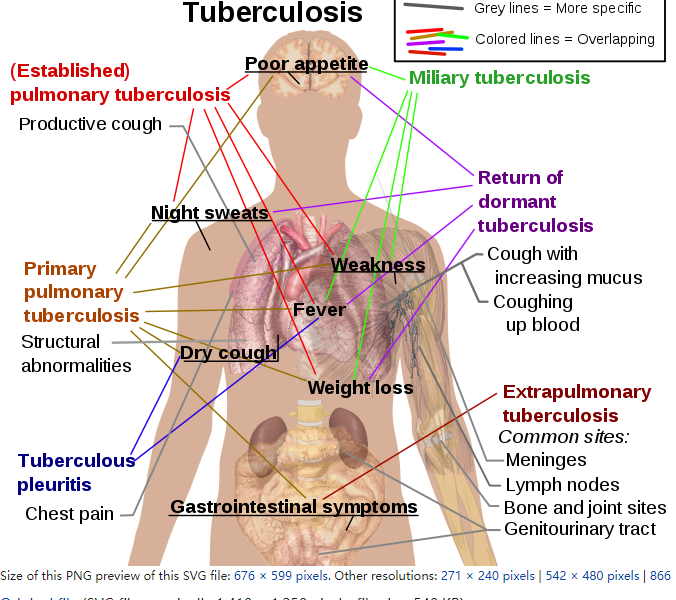
Tuberculosis may infect any part of the body, but most commonly occurs in the lungs (known as pulmonary tuberculosis).[2] Extrapulmonary TB occurs when tuberculosis develops outside of the lungs, although extrapulmonary TB may coexist with pulmonary TB.[2]
General signs and symptoms include fever, chills, night sweats, loss of appetite, weight loss, and fatigue.[2] Significant nail clubbing may also occur.[3]
1.1. Pulmonary
If a tuberculosis infection does become active, it most commonly involves the lungs (in about 90% of cases).[4][5] Symptoms may include chest pain and a prolonged cough producing sputum. About 25% of people may not have any symptoms (i.e. they remain "asymptomatic").[4] Occasionally, people may cough up blood in small amounts, and in very rare cases, the infection may erode into the pulmonary artery or a Rasmussen's aneurysm, resulting in massive bleeding.[2][6] Tuberculosis may become a chronic illness and cause extensive scarring in the upper lobes of the lungs. The upper lung lobes are more frequently affected by tuberculosis than the lower ones.[2] The reason for this difference is not clear.[7] It may be due to either better air flow,[7] or poor lymph drainage within the upper lungs.[2]
1.2. Extrapulmonary
In 15–20% of active cases, the infection spreads outside the lungs, causing other kinds of TB.[8] These are collectively denoted as "extrapulmonary tuberculosis".[9] Extrapulmonary TB occurs more commonly in people with a weakened immune system and young children. In those with HIV, this occurs in more than 50% of cases.[9] Notable extrapulmonary infection sites include the pleura (in tuberculous pleurisy), the central nervous system (in tuberculous meningitis), the lymphatic system (in scrofula of the neck), the genitourinary system (in urogenital tuberculosis), and the bones and joints (in Pott disease of the spine), among others. A potentially more serious, widespread form of TB is called "disseminated tuberculosis", it is also known as miliary tuberculosis.[2] Miliary TB currently makes up about 10% of extrapulmonary cases.[10]
2. Causes
2.1. Mycobacteria
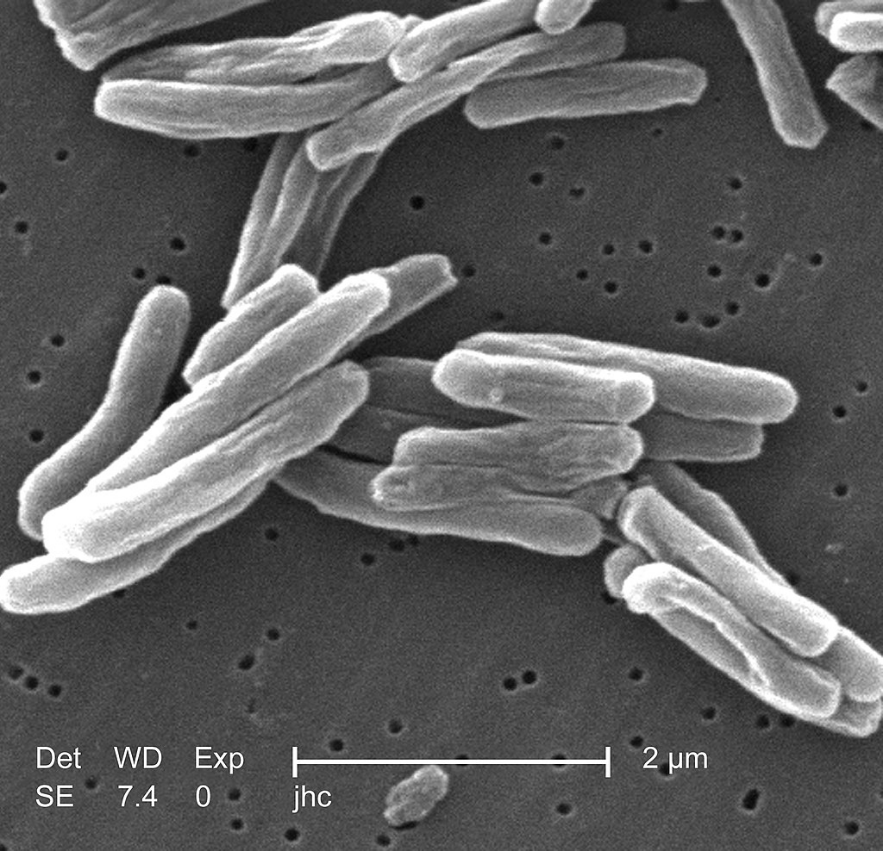
The main cause of TB is Mycobacterium tuberculosis (MTB), a small, aerobic, nonmotile bacillus.[2] The high lipid content of this pathogen accounts for many of its unique clinical characteristics.[11] It divides every 16 to 20 hours, which is an extremely slow rate compared with other bacteria, which usually divide in less than an hour.[12] Mycobacteria have an outer membrane lipid bilayer.[13] If a Gram stain is performed, MTB either stains very weakly "Gram-positive" or does not retain dye as a result of the high lipid and mycolic acid content of its cell wall.[14] MTB can withstand weak disinfectants and survive in a dry state for weeks. In nature, the bacterium can grow only within the cells of a host organism, but M. tuberculosis can be cultured in the laboratory.[15]
Using histological stains on expectorated samples from phlegm (also called "sputum"), scientists can identify MTB under a microscope. Since MTB retains certain stains even after being treated with acidic solution, it is classified as an acid-fast bacillus.[7][14] The most common acid-fast staining techniques are the Ziehl–Neelsen stain[16] and the Kinyoun stain, which dye acid-fast bacilli a bright red that stands out against a blue background.[17] Auramine-rhodamine staining[18] and fluorescence microscopy[19] are also used.
The M. tuberculosis complex (MTBC) includes four other TB-causing mycobacteria: M. bovis, M. africanum, M. canetti, and M. microti.[20] M. africanum is not widespread, but it is a significant cause of tuberculosis in parts of Africa.[21][22] M. bovis was once a common cause of tuberculosis, but the introduction of pasteurized milk has almost completely eliminated this as a public health problem in developed countries.[7][23] M. canetti is rare and seems to be limited to the Horn of Africa, although a few cases have been seen in African emigrants.[24][25] M. microti is also rare and is seen almost only in immunodeficient people, although its prevalence may be significantly underestimated.[26]
Other known pathogenic mycobacteria include M. leprae, M. avium, and M. kansasii. The latter two species are classified as "nontuberculous mycobacteria" (NTM). NTM cause neither TB nor leprosy, but they do cause lung diseases that resemble TB.[27]
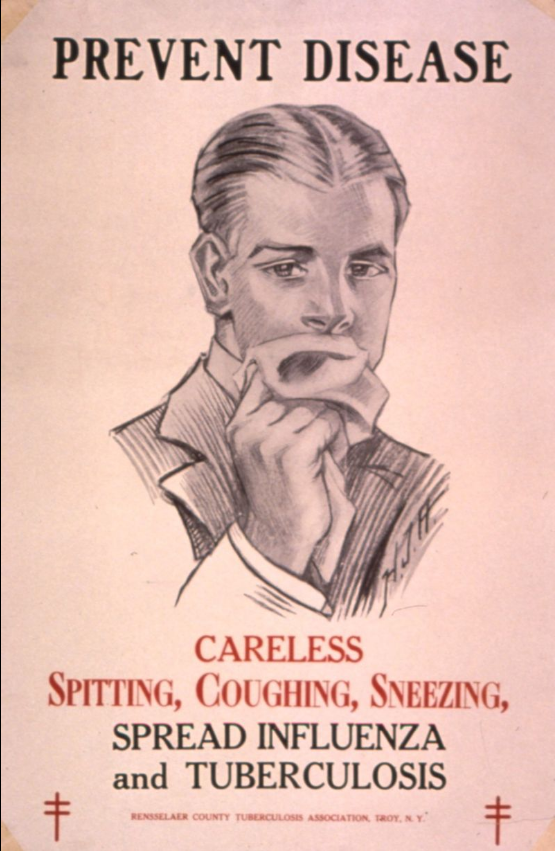
2.2. Transmission
When people with active pulmonary TB cough, sneeze, speak, sing, or spit, they expel infectious aerosol droplets 0.5 to 5.0 µm in diameter. A single sneeze can release up to 40,000 droplets.[28] Each one of these droplets may transmit the disease, since the infectious dose of tuberculosis is very small (the inhalation of fewer than 10 bacteria may cause an infection).[29]
Risk of transmission
People with prolonged, frequent, or close contact with people with TB are at particularly high risk of becoming infected, with an estimated 22% infection rate.[30] A person with active but untreated tuberculosis may infect 10–15 (or more) other people per year.[31] Transmission should occur from only people with active TB – those with latent infection are not thought to be contagious.[7] The probability of transmission from one person to another depends upon several factors, including the number of infectious droplets expelled by the carrier, the effectiveness of ventilation, the duration of exposure, the virulence of the M. tuberculosis strain, the level of immunity in the uninfected person, and others.[32] The cascade of person-to-person spread can be circumvented by segregating those with active ("overt") TB and putting them on anti-TB drug regimens. After about two weeks of effective treatment, subjects with nonresistant active infections generally do not remain contagious to others.[30] If someone does become infected, it typically takes three to four weeks before the newly infected person becomes infectious enough to transmit the disease to others.[33]
2.3. Risk Factors
A number of factors make individuals more susceptible to TB infection and/or disease.[34]
Active disease risk
The most important risk factor globally for developing active TB is concurrent HIV infection; 13% of those with TB are also infected with HIV.[35] This is a particular problem in sub-Saharan Africa, where HIV infection rates are high.[36][37] Of those without HIV infection who are infected with tuberculosis, about 5–10% develop active disease during their lifetimes;[3] in contrast, 30% of those co-infected with HIV develop the active disease.[3]
Use of certain medications, such as corticosteroids and infliximab (an anti-αTNF monoclonal antibody), is another important risk factor, especially in the developed world.[4]
Other risk factors include: alcoholism,[4] diabetes mellitus (3-fold increased risk),[38] silicosis (30-fold increased risk),[39] tobacco smoking (2-fold increased risk),[40] indoor air pollution, malnutrition, young age,[34] recently acquired TB infection, recreational drug use, severe kidney disease, low body weight, organ transplant, head and neck cancer,[41] and genetic susceptibility[42] (the overall importance of genetic risk factors remains undefined[4]).
Infection susceptibility
Tobacco smoking increases the risk of infections (in addition to increasing the risk of active disease and death). Additional factors increasing infection susceptibility include young age.[34]
3. Pathogenesis
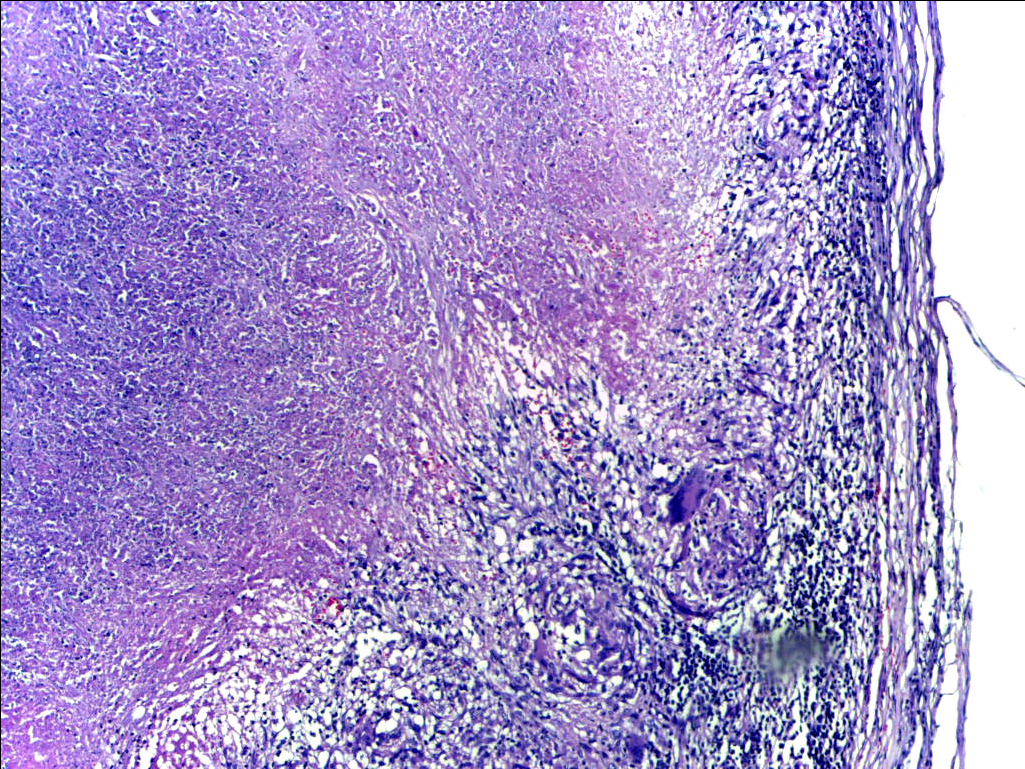
About 90% of those infected with M. tuberculosis have asymptomatic, latent TB infections (sometimes called LTBI),[43] with only a 10% lifetime chance that the latent infection will progress to overt, active tuberculous disease.[44] In those with HIV, the risk of developing active TB increases to nearly 10% a year.[44] If effective treatment is not given, the death rate for active TB cases is up to 66%.[31]
TB infection begins when the mycobacteria reach the alveolar air sacs of the lungs, where they invade and replicate within endosomes of alveolar macrophages.[7][45][46] Macrophages identify the bacterium as foreign and attempt to eliminate it by phagocytosis. During this process, the bacterium is enveloped by the macrophage and stored temporarily in a membrane-bound vesicle called a phagosome. The phagosome then combines with a lysosome to create a phagolysosome. In the phagolysosome, the cell attempts to use reactive oxygen species and acid to kill the bacterium. However, M. tuberculosis has a thick, waxy mycolic acid capsule that protects it from these toxic substances. M. tuberculosis is able to reproduce inside the macrophage and will eventually kill the immune cell.
The primary site of infection in the lungs, known as the "Ghon focus", is generally located in either the upper part of the lower lobe, or the lower part of the upper lobe.[7] Tuberculosis of the lungs may also occur via infection from the blood stream. This is known as a Simon focus and is typically found in the top of the lung.[47] This hematogenous transmission can also spread infection to more distant sites, such as peripheral lymph nodes, the kidneys, the brain, and the bones.[7][48] All parts of the body can be affected by the disease, though for unknown reasons it rarely affects the heart, skeletal muscles, pancreas, or thyroid.[49]
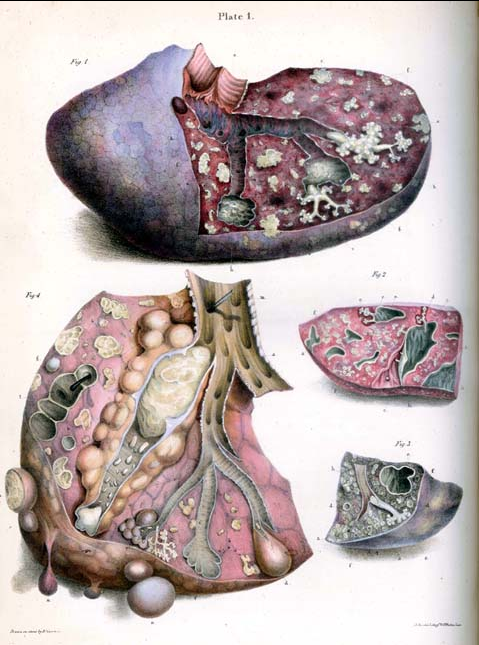
Tuberculosis is classified as one of the granulomatous inflammatory diseases. Macrophages, epithelioid cells, T lymphocytes, B lymphocytes, and fibroblasts aggregate to form granulomas, with lymphocytes surrounding the infected macrophages. When other macrophages attack the infected macrophage, they fuse together to form a giant multinucleated cell in the alveolar lumen. The granuloma may prevent dissemination of the mycobacteria and provide a local environment for interaction of cells of the immune system.[51] However, more recent evidence suggests that the bacteria use the granulomas to avoid destruction by the host's immune system. Macrophages and dendritic cells in the granulomas are unable to present antigen to lymphocytes; thus the immune response is suppressed.[52] Bacteria inside the granuloma can become dormant, resulting in latent infection. Another feature of the granulomas is the development of abnormal cell death (necrosis) in the center of tubercles. To the naked eye, this has the texture of soft, white cheese and is termed caseous necrosis.[51]
If TB bacteria gain entry to the blood stream from an area of damaged tissue, they can spread throughout the body and set up many foci of infection, all appearing as tiny, white tubercles in the tissues.[53] This severe form of TB disease, most common in young children and those with HIV, is called miliary tuberculosis.[54] People with this disseminated TB have a high fatality rate even with treatment (about 30%).[10][55]
In many people, the infection waxes and wanes. Tissue destruction and necrosis are often balanced by healing and fibrosis.[51] Affected tissue is replaced by scarring and cavities filled with caseous necrotic material. During active disease, some of these cavities are joined to the air passages (bronchi) and this material can be coughed up. It contains living bacteria and thus can spread the infection. Treatment with appropriate antibiotics kills bacteria and allows healing to take place. Upon cure, affected areas are eventually replaced by scar tissue.[51]
4. Diagnosis
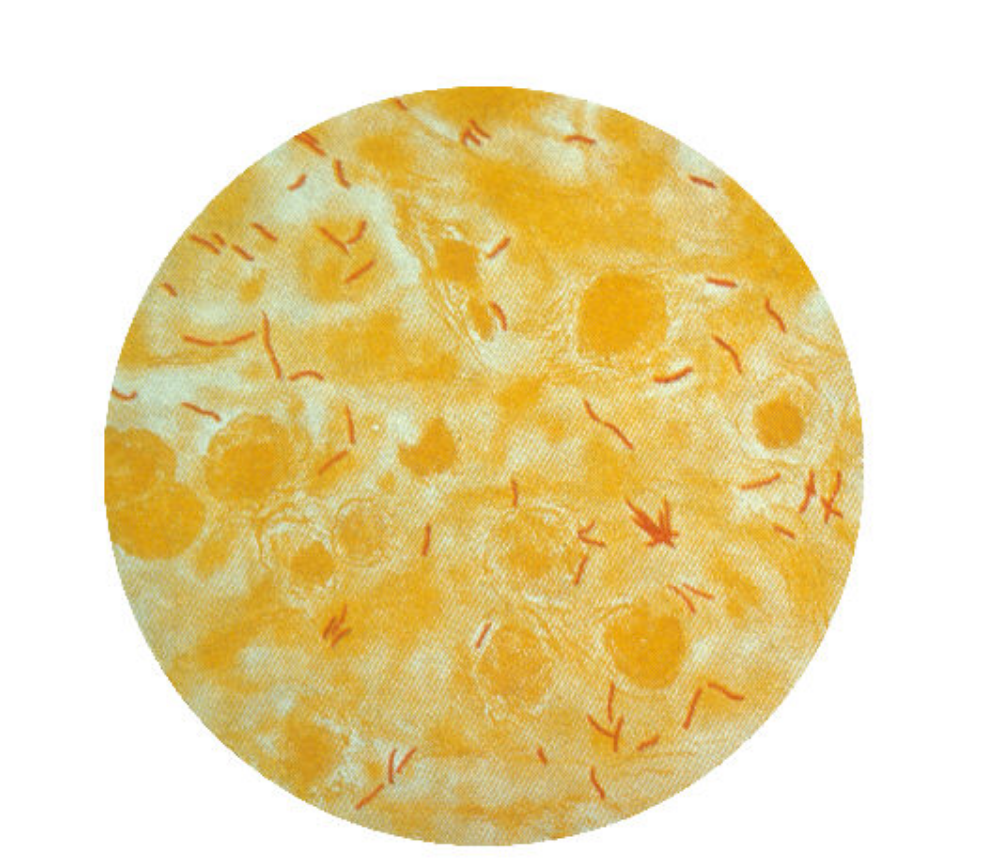
4.1. Active Tuberculosis
Diagnosing active tuberculosis based only on signs and symptoms is difficult,[56] as is diagnosing the disease in those who have a weakened immune system.[57] A diagnosis of TB should, however, be considered in those with signs of lung disease or constitutional symptoms lasting longer than two weeks.[57] A chest X-ray and multiple sputum cultures for acid-fast bacilli are typically part of the initial evaluation.[57] Interferon-γ release assays and tuberculin skin tests are of little use in most of the developing world.[58][59] Interferon gamma release assays (IGRA) have similar limitations in those with HIV.[59][60]
A definitive diagnosis of TB is made by identifying M. tuberculosis in a clinical sample (e.g., sputum, pus, or a tissue biopsy). However, the difficult culture process for this slow-growing organism can take two to six weeks for blood or sputum culture.[61] Thus, treatment is often begun before cultures are confirmed.[62]
Nucleic acid amplification tests and adenosine deaminase testing may allow rapid diagnosis of TB.[56] These tests, however, are not routinely recommended, as they rarely alter how a person is treated.[62] Blood tests to detect antibodies are not specific or sensitive, so they are not recommended.[63]
4.2. Latent Tuberculosis
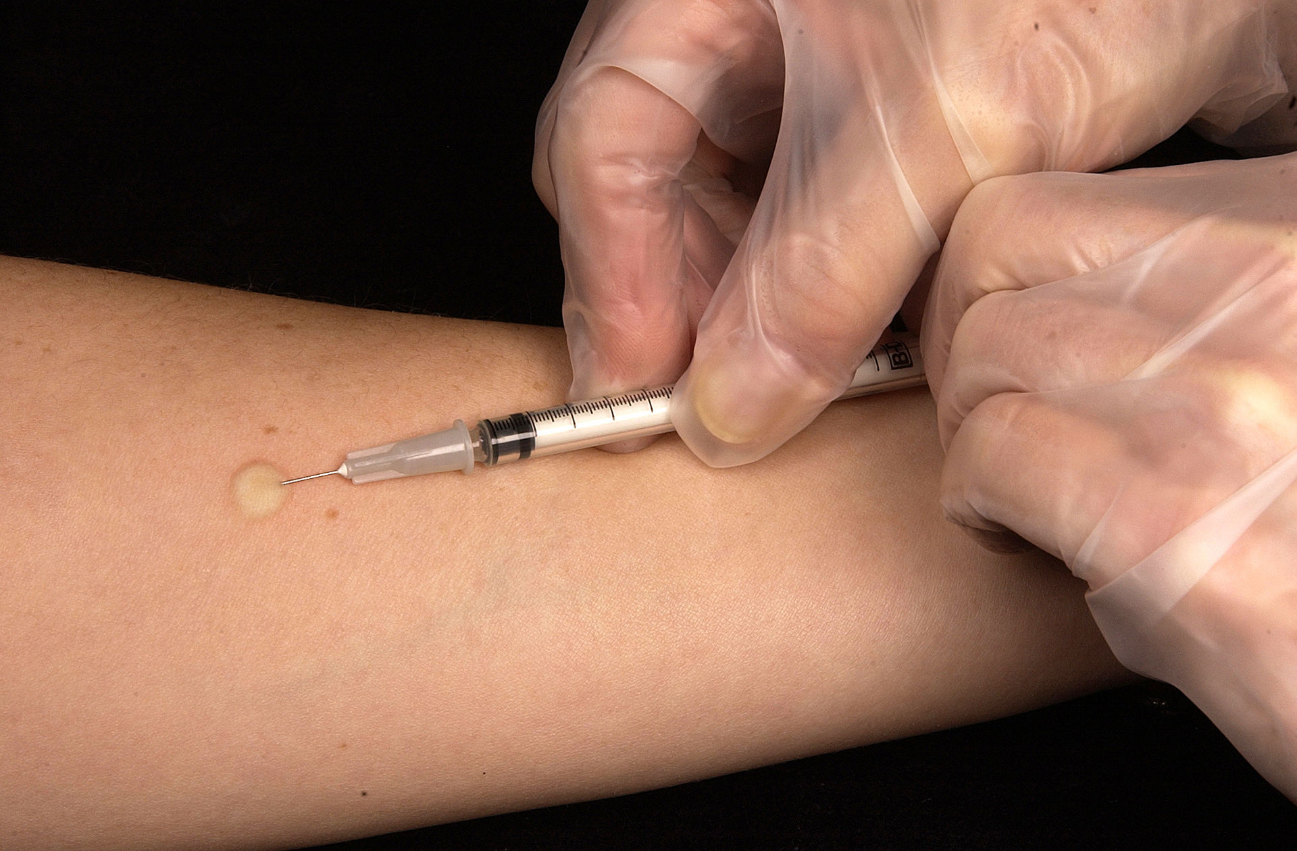
The Mantoux tuberculin skin test is often used to screen people at high risk for TB.[57] Those who have been previously immunized with the Bacille Calmette-Guerin vaccine may have a false-positive test result.[64] The test may be falsely negative in those with sarcoidosis, Hodgkin's lymphoma, malnutrition, and most notably, active tuberculosis.[7] Interferon gamma release assays, on a blood sample, are recommended in those who are positive to the Mantoux test.[62] These are not affected by immunization or most environmental mycobacteria, so they generate fewer false-positive results.[65] However, they are affected by M. szulgai, M. marinum, and M. kansasii.[66] IGRAs may increase sensitivity when used in addition to the skin test, but may be less sensitive than the skin test when used alone.[67]
The US Preventive Services Task Force (USPSTF) has recommended screening people who are at high risk for latent tuberculosis with either tuberculin skin tests or interferon-gamma release assays.[68] While some have recommend testing health care workers, evidence of benefit for this is poor (As of 2019).[69] The Centers for Disease Control and Prevention (CDC) stopped recommending yearly testing of health care workers without known exposure in 2019.[70]
5. Prevention

Tuberculosis prevention and control efforts rely primarily on the vaccination of infants and the detection and appropriate treatment of active cases.[4] The World Health Organization (WHO) has achieved some success with improved treatment regimens, and a small decrease in case numbers.[4]
5.1. Vaccines
The only available vaccine (As of 2011) is Bacillus Calmette-Guérin (BCG).[71] In children it decreases the risk of getting the infection by 20% and the risk of infection turning into active disease by nearly 60%.[72]
It is the most widely used vaccine worldwide, with more than 90% of all children being vaccinated.[4] The immunity it induces decreases after about ten years.[4] As tuberculosis is uncommon in most of Canada, Western Europe, and the United States, BCG is administered to only those people at high risk.[73][74][75] Part of the reasoning against the use of the vaccine is that it makes the tuberculin skin test falsely positive, reducing the test's usefulness as a screening tool.[75] Several vaccines are being developed.[4]
Intradermal MVA85A Vaccine in addition to BCG injection is not effective in preventing tuberculosis.[76]
5.2. Public Health
Public health campaigns which have focused on overcrowding, public spitting and regular sanitation (including hand washing) during the 1800s helped to either interrupt or slow spread which when combined with contact tracing, isolation and treatment helped to dramatically curb the transmission of both tuberculosis and other airborne diseases which lead to the elimination of tuberculosis as a major public health issue in most developed economies.[77][78] Other risk factors which worsened TB spread such as malnutrition were also ameliorated, but since the emergence of HIV a new population of immunocompromised individuals was available for TB to infect.
The World Health Organization (WHO) declared TB a "global health emergency" in 1993,[4] and in 2006, the Stop TB Partnership developed a Global Plan to Stop Tuberculosis that aimed to save 14 million lives between its launch and 2015.[79] A number of targets they set were not achieved by 2015, mostly due to the increase in HIV-associated tuberculosis and the emergence of multiple drug-resistant tuberculosis.[4] A tuberculosis classification system developed by the American Thoracic Society is used primarily in public health programs.[80]
The benefits and risks of giving anti-tubercular drugs in those exposed to MDR-TB is unclear.[81] Making HAART therapy available to HIV-positive individuals significantly reduces the risk of progression to an active TB infection by up to 90% and can mitigate the spread through this population.[82]
6. Treatment

Treatment of TB uses antibiotics to kill the bacteria. Effective TB treatment is difficult, due to the unusual structure and chemical composition of the mycobacterial cell wall, which hinders the entry of drugs and makes many antibiotics ineffective.[83]
Active TB is best treated with combinations of several antibiotics to reduce the risk of the bacteria developing antibiotic resistance.[4] The routine use of rifabutin instead of rifampicin in HIV-positive people with tuberculosis is of unclear benefit (As of 2007).[84]
6.1. Latent
Latent TB is treated with either isoniazid or rifampin alone, or a combination of isoniazid with either rifampicin or rifapentine.[85][86][87]
The treatment takes three to nine months depending on the medications used.[32][85][87][88] People with latent infections are treated to prevent them from progressing to active TB disease later in life.[89]
Education or counselling may improve the latent tuberculosis treatment completion rates.[90]
6.2. New Onset
The recommended treatment of new-onset pulmonary tuberculosis, (As of 2010), is six months of a combination of antibiotics containing rifampicin, isoniazid, pyrazinamide, and ethambutol for the first two months, and only rifampicin and isoniazid for the last four months.[4] Where resistance to isoniazid is high, ethambutol may be added for the last four months as an alternative.[4] Treatment with anti-TB drugs for at least 6 months results in higher success rates when compared with treatment less than 6 months; even though the difference is small. Shorter treatment regimen may be recommended for those with compliance issues.[91] There is also no evidence to support shorter anti-tuberculosis treatment regimens when compared to a 6-month treatment regimen.[92]
6.3. Recurrent Disease
If tuberculosis recurs, testing to determine which antibiotics it is sensitive to is important before determining treatment.[4] If multiple drug-resistant TB (MDR-TB) is detected, treatment with at least four effective antibiotics for 18 to 24 months is recommended.[4]
6.4. Medication Administration
Directly observed therapy, i.e., having a health care provider watch the person take their medications, is recommended by the World Health Organization (WHO) in an effort to reduce the number of people not appropriately taking antibiotics.[93] The evidence to support this practice over people simply taking their medications independently is of poor quality.[94] There is no strong evidence indicating that directly observed therapy improves the number of people who were cured or the number of people who complete their medicine.[94] Moderate quality evidence suggests that there is also no difference if people are observed at home versus at a clinic, or by a family member versus a health care worker.[94] Methods to remind people of the importance of treatment and appointments may result in a small but important improvement.[95] There is also not enough evidence to support intermittent rifampicin-containing therapy given two to three times a week has equal effectiveness as daily dose regimen on improving cure rates and reducing relapsing rates.[96] There is also not enough evidence on effectiveness of giving intermittent twice or thrice weekly short course regimen compared to daily dosing regimen in treating children with tuberculosis.[97]
6.5. Medication Resistance
Primary resistance occurs when a person becomes infected with a resistant strain of TB. A person with fully susceptible MTB may develop secondary (acquired) resistance during therapy because of inadequate treatment, not taking the prescribed regimen appropriately (lack of compliance), or using low-quality medication.[98] Drug-resistant TB is a serious public health issue in many developing countries, as its treatment is longer and requires more expensive drugs. MDR-TB is defined as resistance to the two most effective first-line TB drugs: rifampicin and isoniazid. Extensively drug-resistant TB is also resistant to three or more of the six classes of second-line drugs.[99] Totally drug-resistant TB is resistant to all currently used drugs.[100] It was first observed in 2003 in Italy,[101] but not widely reported until 2012,[100][102] and has also been found in Iran and India.[103][104] Bedaquiline is tentatively supported for use in multiple drug-resistant TB.[105]
XDR-TB is a term sometimes used to define extensively resistant TB, and constitutes one in ten cases of MDR-TB. Cases of XDR TB have been identified in more than 90% of countries.[103] There is some efficacy for linezolid to treat those with XDR-TB but side effects and discontinuation of medications were common.[106]
For those with known rifampicin or MDR-TB, Genotype® MTBDRsl Assay performed on culture isolates or smear positive specimens may be useful to detect second-line anti-tubercular drug resistance.[107]
7. Prognosis
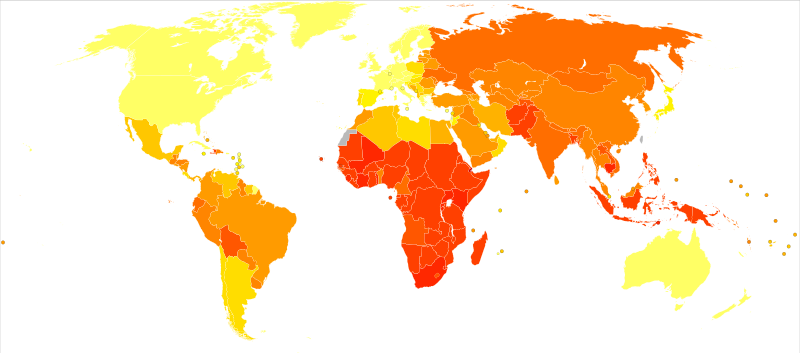

Progression from TB infection to overt TB disease occurs when the bacilli overcome the immune system defenses and begin to multiply. In primary TB disease (some 1–5% of cases), this occurs soon after the initial infection.[7] However, in the majority of cases, a latent infection occurs with no obvious symptoms.[7] These dormant bacilli produce active tuberculosis in 5–10% of these latent cases, often many years after infection.[3]
The risk of reactivation increases with immunosuppression, such as that caused by infection with HIV. In people coinfected with M. tuberculosis and HIV, the risk of reactivation increases to 10% per year.[7] Studies using DNA fingerprinting of M. tuberculosis strains have shown reinfection contributes more substantially to recurrent TB than previously thought,[109] with estimates that it might account for more than 50% of reactivated cases in areas where TB is common.[110] The chance of death from a case of tuberculosis is about 4% (As of 2008), down from 8% in 1995.[4]
In people with smear-positive pulmonary TB (without HIV co-infection), after 5 years without treatment, 50-60% die while 20-25% achieve spontaneous resolution (cure). TB is almost always fatal in those with untreated HIV co-infection and death rates are increased even with antiretroviral treatment of HIV.[111]
8. Epidemiology
Roughly one-quarter of the world's population has been infected with M. tuberculosis,[112] with new infections occurring in about 1% of the population each year.[113] However, most infections with M. tuberculosis do not cause disease,[114] and 90–95% of infections remain asymptomatic.[43] In 2012, an estimated 8.6 million chronic cases were active.[115] In 2010, 8.8 million new cases of tuberculosis were diagnosed, and 1.20–1.45 million deaths occurred (most of these occurring in developing countries).[35][116] Of these, about 0.35 million occur in those also infected with HIV.[117] In 2018, tuberculosis was the leading cause of death worldwide from a single infectious agent.[118] The total number of tuberculosis cases has been decreasing since 2005, while new cases have decreased since 2002.[35]
Tuberculosis incidence is seasonal, with peaks occurring every spring and summer.[119][120][121][122] The reasons for this are unclear, but may be related to vitamin D deficiency during the winter.[122][123] There are also studies linking tuberculosis to different weather conditions like low temperature, low humidity and low rainfall. It has been suggested that tuberculosis incidence rates may be connected to climate change.[124]
8.1. At-Risk Groups
Tuberculosis is closely linked to both overcrowding and malnutrition, making it one of the principal diseases of poverty.[4] Those at high risk thus include: people who inject illicit drugs, inhabitants and employees of locales where vulnerable people gather (e.g., prisons and homeless shelters), medically underprivileged and resource-poor communities, high-risk ethnic minorities, children in close contact with high-risk category patients, and health-care providers serving these patients.[125]
The rate of tuberculosis varies with age. In Africa, it primarily affects adolescents and young adults.[126] However, in countries where incidence rates have declined dramatically (such as the United States), tuberculosis is mainly a disease of the elderly and immunocompromised (risk factors are listed above).[7][127] Worldwide, 22 "high-burden" states or countries together experience 80% of cases as well as 83% of deaths.[103]
In Canada and Australia, tuberculosis is many times more common among the aboriginal peoples, especially in remote areas.[128][129] Factors contributing to this include higher prevalence of predisposing health conditions and behaviours, and overcrowding and poverty. In some Canadian aboriginal groups, genetic susceptibility may play a role.[34]
Socioeconomic status (SES) strongly affects TB risk. People of low SES are both more likely to contract TB and to be more severely affected by the disease. Those with low SES are more likely to be affected by risk factors for developing TB (e.g. malnutrition, indoor air pollution, HIV co-infection, etc.), and are additionally more likely to be exposed to crowded and poorly ventilated spaces. Inadequate healthcare also means that people with active disease who facilitate spread are not diagnosed and treated promptly; sick people thus remain in the infectious state and (continue to) spread the infection.[34]
8.2. Geographical Epidemiology
The distribution of tuberculosis is not uniform across the globe; about 80% of the population in many African, Caribbean, South Asian, and eastern European countries test positive in tuberculin tests, while only 5–10% of the U.S. population test positive.[7] Hopes of totally controlling the disease have been dramatically dampened because of many factors, including the difficulty of developing an effective vaccine, the expensive and time-consuming diagnostic process, the necessity of many months of treatment, the increase in HIV-associated tuberculosis, and the emergence of drug-resistant cases in the 1980s.[4]
In developed countries, tuberculosis is less common and is found mainly in urban areas. In Europe, deaths from TB fell from 500 out of 100,000 in 1850 to 50 out of 100,000 by 1950. Improvements in public health were reducing tuberculosis even before the arrival of antibiotics, although the disease remained a significant threat to public health, such that when the Medical Research Council was formed in Britain in 1913 its initial focus was tuberculosis research.[130]
In 2010, rates per 100,000 people in different areas of the world were: globally 178, Africa 332, the Americas 36, Eastern Mediterranean 173, Europe 63, Southeast Asia 278, and Western Pacific 139.[117]
Russia
Russia has achieved particularly dramatic progress with a decline in its TB mortality rate—from 61.9 per 100,000 in 1965 to 2.7 per 100,000 in 1993;[131][132] however, mortality rate increased to 24 per 100,000 in 2005 and then recoiled to 11 per 100,000 by 2015.[133]
China
China has achieved particularly dramatic progress, with about an 80% reduction in its TB mortality rate between 1990 and 2010.[117] The number of new cases has declined by 17% between 2004 and 2014.[103]
Africa
In 2007, the country with the highest estimated incidence rate of TB was Eswatini, with 1,200 cases per 100,000 people. In 2017, the country with the highest estimated incidence rate as a % of the population was Lesotho, with 665 cases per 100,000 people.[134]
India
As of 2017, India had the largest total incidence, with an estimated 2 740 000 cases.[134] According to the World Health Organization (WHO), in 2000–2015, India's estimated mortality rate dropped from 55 to 36 per 100 000 population per year with estimated 480 thousand people died of TB in 2015.[135][136] In India a major proportion of tuberculosis patient are being treated by private partners and private hospitals. Evidence indicates that the tuberculosis national survey does not represent the number of cases that are diagnosed and recorded by private clinics and hospitals in India.[137]
North America
In the United States Native Americans have a fivefold greater mortality from TB,[138] and racial and ethnic minorities accounted for 84% of all reported TB cases.[139]
In the United States, the overall tuberculosis case rate was 3 per 100,000 persons in 2017.[134] In Canada, tuberculosis is still endemic in some rural areas.[140]
Western Europe
In 2017, in the United Kingdom, the national average was 9 per 100,000 and the highest incidence rates in Western Europe were 20 per 100,000 in Portugal.
-
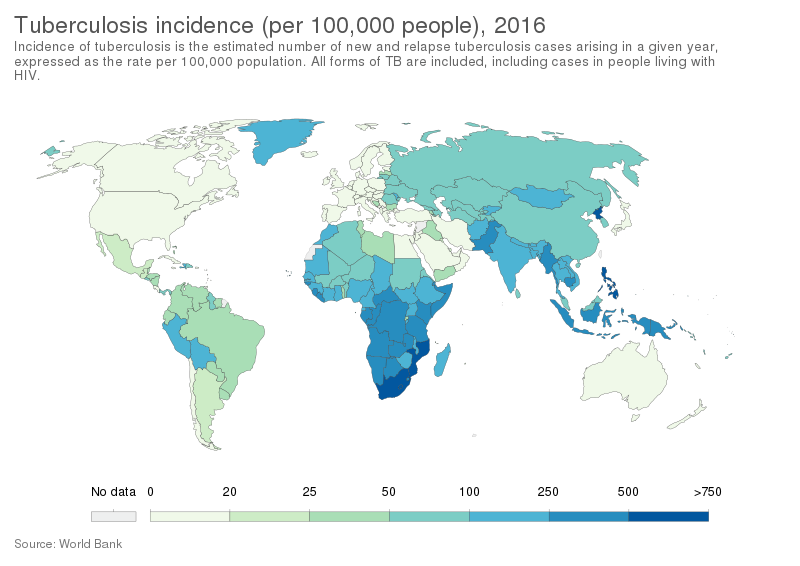
Number of new cases of tuberculosis per 100,000 people in 2016.[141] By Our World In Data - https://ourworldindata.org/grapher/incidence-of-tuberculosis-sdgs, CC BY 3.0, https://commons.wikimedia.org/w/index.php?curid=86956073
-
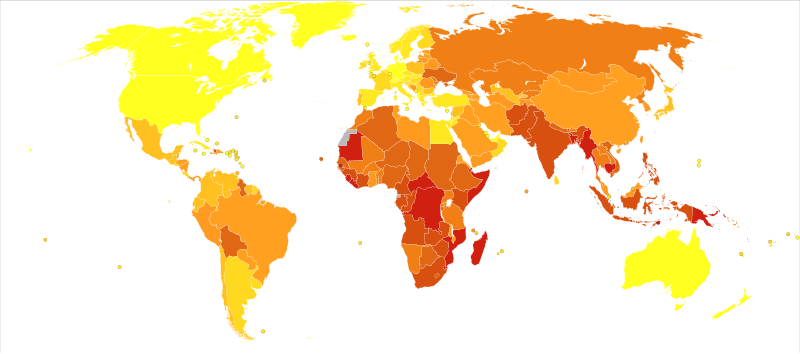
Tuberculosis deaths per million persons in 2012. By Chris55 - Data from World Health Organization Estimated Deaths 2012 Vector map from BlankMap-World6, compact.svg by Canuckguy et al., CC BY-SA 4.0, https://commons.wikimedia.org/w/index.php?curid=50321512
-
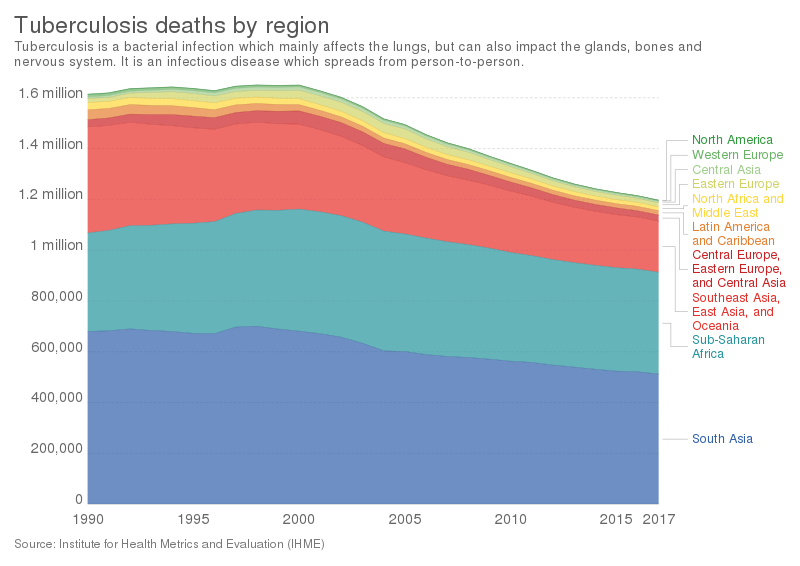
Tuberculosis deaths by region, 1990 to 2017.[142] By Our World In Data - https://ourworldindata.org/grapher/tuberculosis-deaths-region, CC BY 3.0, https://commons.wikimedia.org/w/index.php?curid=86956055
9. History

Tuberculosis has existed since antiquity.[4] The oldest unambiguously detected M. tuberculosis gives evidence of the disease in the remains of bison in Wyoming dated to around 17,000 years ago.[143] However, whether tuberculosis originated in bovines, then transferred to humans, or whether both bovine and human tuberculosis diverged from a common ancestor, remains unclear.[144] A comparison of the genes of M. tuberculosis complex (MTBC) in humans to MTBC in animals suggests humans did not acquire MTBC from animals during animal domestication, as researchers previously believed. Both strains of the tuberculosis bacteria share a common ancestor, which could have infected humans even before the Neolithic Revolution.[145] Skeletal remains show some prehistoric humans (4000 BC) had TB, and researchers have found tubercular decay in the spines of Egyptian mummies dating from 3000 to 2400 BC.[146] Genetic studies suggest the presence of TB in the Americas from about 100 AD.[147]
Before the Industrial Revolution, folklore often associated tuberculosis with vampires. When one member of a family died from the disease, the other infected members would lose their health slowly. People believed this was caused by the original person with TB draining the life from the other family members.[148]
Although Richard Morton established the pulmonary form associated with tubercles as a pathology in 1689,[149][150] due to the variety of its symptoms, TB was not identified as a single disease until the 1820s. Benjamin Marten conjectured in 1720 that consumptions were caused by microbes which were spread by people living in close proximity to each other.[151] In 1819 René Laennec claimed that tubercles were the cause of pulmonary tuberculosis.[152] J. L. Schönlein first published the name "tuberculosis" (German: Tuberkulose) in 1832.[153][154] Between 1838 and 1845, Dr. John Croghan, the owner of Mammoth Cave in Kentucky from 1839 onwards, brought a number of people with tuberculosis into the cave in the hope of curing the disease with the constant temperature and purity of the cave air; each died within a year.[155] Hermann Brehmer opened the first TB sanatorium in 1859 in Görbersdorf (now Sokołowsko) in Silesia.[156] In 1865 Jean Antoine Villemin demonstrated that tuberculosis could be transmitted, via inoculation, from humans to animals and among animals.[157] (Villemin's findings were confirmed in 1867 and 1868 by John Burdon-Sanderson.[158])
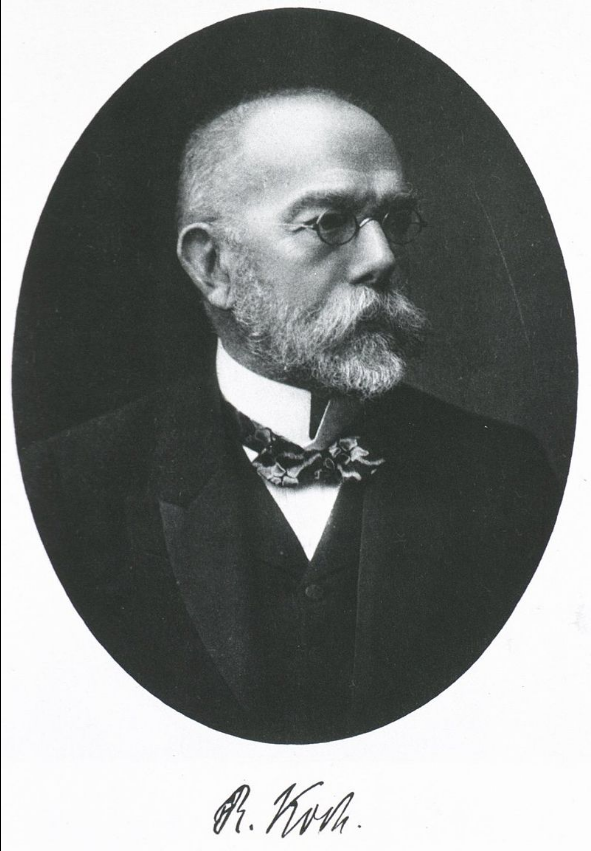
Robert Koch identified and described the bacillus causing tuberculosis, M. tuberculosis, on 24 March 1882.[159] He received the Nobel Prize in Physiology or Medicine in 1905 for this discovery.[160] Koch did not believe the cattle and human tuberculosis diseases were similar, which delayed the recognition of infected milk as a source of infection. During the first half of the 1900s the risk of transmission from this source was dramatically reduced after the application of the pasteurization process. Koch announced a glycerine extract of the tubercle bacilli as a "remedy" for tuberculosis in 1890, calling it "tuberculin". Although it was not effective, it was later successfully adapted as a screening test for the presence of pre-symptomatic tuberculosis.[161] World Tuberculosis Day is marked on 24 March each year, the anniversary of Koch's original scientific announcement.
Albert Calmette and Camille Guérin achieved the first genuine success in immunization against tuberculosis in 1906, using attenuated bovine-strain tuberculosis. It was called bacille Calmette–Guérin (BCG). The BCG vaccine was first used on humans in 1921 in France,[162] but achieved widespread acceptance in the US, Great Britain, and Germany only after World War II.[163]
Tuberculosis caused widespread public concern in the 19th and early 20th centuries as the disease became common among the urban poor. In 1815 one in four deaths in England was due to "consumption". By 1918, TB still caused one in six deaths in France. After TB was determined to be contagious, in the 1880s, it was put on a notifiable-disease list in Britain; campaigns started to stop people from spitting in public places, and the infected poor were "encouraged" to enter sanatoria that resembled prisons (the sanatoria for the middle and upper classes offered excellent care and constant medical attention).[156] Whatever the benefits of the "fresh air" and labor in the sanatoria, even under the best conditions, 50% of those who entered died within five years (c. 1916).[156] When the Medical Research Council formed in Britain in 1913, it initially focused on tuberculosis research.[164]
In Europe, rates of tuberculosis began to rise in the early 1600s to a peak level in the 1800s, when it caused nearly 25% of all deaths.[165] In the 18th and 19th century, tuberculosis had become epidemic in Europe, showing a seasonal pattern.[166][167] By the 1950s mortality in Europe had decreased about 90%.[168] Improvements in sanitation, vaccination, and other public-health measures began significantly reducing rates of tuberculosis even before the arrival of streptomycin and other antibiotics, although the disease remained a significant threat.[168] In 1946 the development of the antibiotic streptomycin made effective treatment and cure of TB a reality. Prior to the introduction of this medication, the only treatment was surgical intervention, including the "pneumothorax technique", which involved collapsing an infected lung to "rest" it and to allow tuberculous lesions to heal.[169]
Because of the emergence of MDR-TB, surgery has been re-introduced for certain cases of TB infections. It involves the removal of infected chest cavities ("bullae") in the lungs to reduce the number of bacteria and to increase exposure of the remaining bacteria to antibiotics in the bloodstream.[170] Hopes of completely eliminating TB ended with the rise of drug-resistant strains in the 1980s. The subsequent resurgence of tuberculosis resulted in the declaration of a global health emergency by the World Health Organization (WHO) in 1993.[171]
10. Society and Culture
10.1. Names
Tuberculosis has been known by many names from the technical to the familiar.[172] Phthisis (Φθισις) is a Greek word for consumption, an old term for pulmonary tuberculosis;[173] around 460 BCE, Hippocrates described phthisis as a disease of dry seasons.[174] The abbreviation "TB" is short for tubercle bacillus. "Consumption" was the most common nineteenth century English word for the disease. The Latin root "con" meaning "completely" is linked to "sumere" meaning "to take up from under."[175] In The Life and Death of Mr Badman by John Bunyan, the author calls consumption "the captain of all these men of death."[176] "Great white plague" has also been used.[172]
10.2. Art and Literature

Tuberculosis was for centuries associated with poetic and artistic qualities among those infected, and was also known as "the romantic disease".[172][177] Major artistic figures such as the poets John Keats, Percy Bysshe Shelley, and Edgar Allan Poe, the composer Frédéric Chopin,[178] the playwright Anton Chekhov, the novelists Franz Kafka, Katherine Mansfield,[179] Charlotte Brontë, Fyodor Dostoevsky, Thomas Mann, W. Somerset Maugham,[180] George Orwell,[181] and Robert Louis Stevenson, and the artists Alice Neel,[182] Jean-Antoine Watteau, Elizabeth Siddal, Marie Bashkirtseff, Edvard Munch, Aubrey Beardsley and Amedeo Modigliani either had the disease or were surrounded by people who did. A widespread belief was that tuberculosis assisted artistic talent. Physical mechanisms proposed for this effect included the slight fever and toxaemia that it caused, allegedly helping them to see life more clearly and to act decisively.[183][184][185]
Tuberculosis formed an often-reused theme in literature, as in Thomas Mann's The Magic Mountain, set in a sanatorium;[186] in music, as in Van Morrison's song "T.B. Sheets";[187] in opera, as in Puccini's La bohème and Verdi's La Traviata;[185] in art, as in Monet's painting of his first wife Camille on her deathbed;[188] and in film, such as the 1945 The Bells of St. Mary's starring Ingrid Bergman as a nun with tuberculosis.[189]
10.3. Public Health Efforts
The World Health Organization (WHO), the Bill and Melinda Gates Foundation, and the U.S. government are subsidizing a fast-acting diagnostic tuberculosis test for use in low- and middle-income countries as of 2012.[190][191][192] In addition to being fast-acting, the test can determine if there is resistance to the antibiotic rifampicin which may indicate multi-drug resistant tuberculosis and is accurate in those who are also infected with HIV.[190][193] Many resource-poor places (As of 2011) have access to only sputum microscopy.[194]
India had the highest total number of TB cases worldwide in 2010, in part due to poor disease management within the private and public health care sector. Programs such as the Revised National Tuberculosis Control Program are working to reduce TB levels among people receiving public health care.[195][196]
A 2014 EIU-healthcare report finds there is a need to address apathy and urges for increased funding. The report cites among others Lucica Ditui "[TB] is like an orphan. It has been neglected even in countries with a high burden and often forgotten by donors and those investing in health interventions."[103]
Slow progress has led to frustration, expressed by the executive director of the Global Fund to Fight AIDS, Tuberculosis and Malaria – Mark Dybul: "we have the tools to end TB as a pandemic and public health threat on the planet, but we are not doing it."[103] Several international organizations are pushing for more transparency in treatment, and more countries are implementing mandatory reporting of cases to the government as of 2014, although adherence is often variable. Commercial treatment providers may at times overprescribe second-line drugs as well as supplementary treatment, promoting demands for further regulations.[103] The government of Brazil provides universal TB care, which reduces this problem.[103] Conversely, falling rates of TB infection may not relate to the number of programs directed at reducing infection rates but may be tied to an increased level of education, income, and health of the population.[103] Costs of the disease, as calculated by the World Bank in 2009 may exceed US$150 billion per year in "high burden" countries.[103] Lack of progress eradicating the disease may also be due to lack of patient follow-up – as among the 250M rural migrants in China.[103]
There is insufficient data to show that active contact tracing helps to improve case detection rates for tuberculosis.[197] Interventions such as house-to-house visits, educational leaflets, mass media strategies, educational sessions may increase tuberculosis detection rates in short-term.[198] There is no study that compare new method of contact tracing such as social network analysis with existing contact tracing methods.[199]
10.4. Stigma
Slow progress in preventing the disease may in part be due to stigma associated with TB.[103] Stigma may be due to the fear of transmission from affected individuals. This stigma may additionally arise due to links between TB and poverty, and in Africa, AIDS.[103] Such stigmatization may be both real and perceived; for example, in Ghana individuals with TB are banned from attending public gatherings.[200]
Stigma towards TB may result in delays in seeking treatment,[103] lower treatment compliance, and family members keeping cause of death secret[200] – allowing the disease to spread further.[103] In contrast, in Russia stigma was associated with increased treatment compliance.[200] TB stigma also affects socially marginalized individuals to a greater degree and varies between regions.[200]
One way to decrease stigma may be through the promotion of "TB clubs", where those infected may share experiences and offer support, or through counseling.[200] Some studies have shown TB education programs to be effective in decreasing stigma, and may thus be effective in increasing treatment adherence.[200] Despite this, studies on the relationship between reduced stigma and mortality are lacking (As of 2010), and similar efforts to decrease stigma surrounding AIDS have been minimally effective.[200] Some have claimed the stigma to be worse than the disease, and healthcare providers may unintentionally reinforce stigma, as those with TB are often perceived as difficult or otherwise undesirable.[103] A greater understanding of the social and cultural dimensions of tuberculosis may also help with stigma reduction.[201]
11. Research
The BCG vaccine has limitations, and research to develop new TB vaccines is ongoing.[202] A number of potential candidates are currently in phase I and II clinical trials.[202][203] Two main approaches are used to attempt to improve the efficacy of available vaccines. One approach involves adding a subunit vaccine to BCG, while the other strategy is attempting to create new and better live vaccines.[202] MVA85A, an example of a subunit vaccine, is in trials in South Africa as of 2006, is based on a genetically modified vaccinia virus.[204] Vaccines are hoped to play a significant role in treatment of both latent and active disease.[205]
To encourage further discovery, researchers and policymakers are promoting new economic models of vaccine development as of 2006, including prizes, tax incentives, and advance market commitments.[206][207] A number of groups, including the Stop TB Partnership,[208] the South African Tuberculosis Vaccine Initiative, and the Aeras Global TB Vaccine Foundation, are involved with research.[209] Among these, the Aeras Global TB Vaccine Foundation received a gift of more than $280 million (US) from the Bill and Melinda Gates Foundation to develop and license an improved vaccine against tuberculosis for use in high burden countries.[210][211]
A number of medications are being studied as of 2012 for multidrug-resistant tuberculosis, including bedaquiline and delamanid.[212] Bedaquiline received U.S. Food and Drug Administration (FDA) approval in late 2012.[213] The safety and effectiveness of these new agents are uncertain as of 2012, because they are based on the results of relatively small studies.[212][214] However, existing data suggest that patients taking bedaquiline in addition to standard TB therapy are five times more likely to die than those without the new drug,[215] which has resulted in medical journal articles raising health policy questions about why the FDA approved the drug and whether financial ties to the company making bedaquiline influenced physicians' support for its use.[214][216]
Steroids add-on therapy has not shown any benefits for people with active pulmonary tuberculosis infection.[217]
12. Other Animals
Mycobacteria infect many different animals, including birds,[218] fish, rodents,[219] and reptiles.[220] The subspecies Mycobacterium tuberculosis, though, is rarely present in wild animals.[221] An effort to eradicate bovine tuberculosis caused by Mycobacterium bovis from the cattle and deer herds of New Zealand has been relatively successful.[222] Efforts in Great Britain have been less successful.[223][224]
(As of 2015), tuberculosis appears to be widespread among captive elephants in the US. It is believed that the animals originally acquired the disease from humans, a process called reverse zoonosis. Because the disease can spread through the air to infect both humans and other animals, it is a public health concern affecting circuses and zoos.[225][226]
References
- "Tuberculosis Symptoms". eMedicine Health. 15 January 2009. http://www.emedicinehealth.com/tuberculosis/page3_em.htm.
- Adkinson, N Franklin; Bennett, John E; Douglas, Robert Gordon; Mandell, Gerald L (2010). Mandell, Douglas, and Bennett's principles and practice of infectious diseases (7th ed.). Philadelphia, PA: Churchill Livingstone/Elsevier. p. Chapter 250. ISBN 978-0-443-06839-3.
- Evidence-Based Respiratory Medicine (1st ed.). BMJ Books. 2005. p. 321. ISBN 978-0-7279-1605-1. http://www.wiley.com/WileyCDA/WileyTitle/productCd-072791605X.html.
- "Tuberculosis". Lancet 378 (9785): 57–72. July 2011. doi:10.1016/S0140-6736(10)62173-3. PMID 21420161. https://www.semanticscholar.org/paper/a18da0d39f1a2c68d3eee0529e35f7d2bd715803.
- Textbook of Pulmonary Medicine (2nd ed.). New Delhi: Jaypee Brothers Medical Publishers. 2010. p. 457. ISBN 978-81-8448-749-7. https://books.google.com/books?id=0TbJjd9eTp0C&pg=PA457.
- "Thoracic surgery for haemoptysis in the context of tuberculosis: what is the best management approach?". Journal of Thoracic Disease 6 (3): 182–85. March 2014. doi:10.3978/j.issn.2072-1439.2013.12.25. PMID 24624281. http://www.pubmedcentral.nih.gov/articlerender.fcgi?tool=pmcentrez&artid=3949181
- Kumar, Vinay; Robbins, Stanley L. (2007). Robbins Basic Pathology (8th ed.). Philadelphia: Elsevier. ISBN 978-1-4160-2973-1. OCLC 69672074. http://www.worldcat.org/oclc/69672074
- Textbook of Pulmonary and Critical Care Medicine. New Delhi: Jaypee Brothers Medical Publishers. 2011. p. 549. ISBN 978-93-5025-073-0. https://books.google.com/books?id=EvGTw3wn-zEC&pg=PA549.
- "Extrapulmonary tuberculosis: an overview". American Family Physician 72 (9): 1761–68. November 2005. PMID 16300038. http://www.ncbi.nlm.nih.gov/pubmed/16300038
- Habermann, Thomas M; Ghosh, Amit (2008). Mayo Clinic internal medicine: concise textbook. Rochester, MN: Mayo Clinic Scientific Press. p. 789. ISBN 978-1-4200-6749-1. https://books.google.com/books?id=YJtodBwNxokC&pg=PA789.
- "Chapter 4: Pulmonary Infections". Infectious Diseases: A Clinical Short Course, 2nd ed.. McGraw-Hill Medical Publishing Division. 2007. pp. 104, 313–14. ISBN 978-0-07-147722-2.
- Textbook of Pulmonary and Critical Care Medicine. New Delhi: Jaypee Brothers Medical Publishers. 2011. p. 525. ISBN 978-93-5025-073-0. https://books.google.com/books?id=rAT1bdnDakAC&pg=PA525.
- "Mycobacterial outer membranes: in search of proteins". Trends in Microbiology 18 (3): 109–16. March 2010. doi:10.1016/j.tim.2009.12.005. PMID 20060722. http://www.pubmedcentral.nih.gov/articlerender.fcgi?tool=pmcentrez&artid=2931330
- "Application of stains in clinical microbiology". Biotechnic & Histochemistry 76 (3): 119–25. May 2001. doi:10.1080/714028138. PMID 11475314. https://dx.doi.org/10.1080%2F714028138
- "Mycobacteria: bugs and bugbears (two steps forward and one step back)". Molecular Biotechnology 13 (3): 191–200. December 1999. doi:10.1385/MB:13:3:191. PMID 10934532. https://www.semanticscholar.org/paper/f772c9046705c7df7e2be5d8bfcee869bd54f470.
- Medical Laboratory Science: Theory and Practice. New Delhi: Tata McGraw-Hill. 2000. p. 473. ISBN 978-0-07-463223-9. https://books.google.com/books?id=lciNs3VQPLoC&pg=PA473.
- "Acid-Fast Stain Protocols". 21 August 2013. http://www.microbelibrary.org/component/resource/laboratory-test/2870-acid-fast-stain-protocols.
- "Nontuberculous mycobacterial infections: comparison of the fluorescent auramine-O and Ziehl-Neelsen techniques in tissue diagnosis". Human Pathology 15 (11): 1085–9. November 1984. doi:10.1016/S0046-8177(84)80253-1. PMID 6208117. https://dx.doi.org/10.1016%2FS0046-8177%2884%2980253-1
- Nutrition and health in developing countries (2nd ed.). Totowa, N.J.: Humana Press. 2008. p. 291. ISBN 978-1-934115-24-4. https://books.google.com/books?id=RhH6uSQy7a4C&pg=PA291.
- "A novel pathogenic taxon of the Mycobacterium tuberculosis complex, Canetti: characterization of an exceptional isolate from Africa". International Journal of Systematic Bacteriology 47 (4): 1236–45. October 1997. doi:10.1099/00207713-47-4-1236. PMID 9336935. https://dx.doi.org/10.1099%2F00207713-47-4-1236
- "Mycobacterium africanum subtype II is associated with two distinct genotypes and is a major cause of human tuberculosis in Kampala, Uganda". Journal of Clinical Microbiology 40 (9): 3398–405. September 2002. doi:10.1128/JCM.40.9.3398-3405.2002. PMID 12202584. http://www.pubmedcentral.nih.gov/articlerender.fcgi?tool=pmcentrez&artid=130701
- "Genetic biodiversity of Mycobacterium tuberculosis complex strains from patients with pulmonary tuberculosis in Cameroon". Journal of Clinical Microbiology 41 (6): 2547–53. June 2003. doi:10.1128/JCM.41.6.2547-2553.2003. PMID 12791879. http://www.pubmedcentral.nih.gov/articlerender.fcgi?tool=pmcentrez&artid=156567
- "The importance of Mycobacterium bovis as a zoonosis". Veterinary Microbiology 112 (2–4): 339–45. February 2006. doi:10.1016/j.vetmic.2005.11.047. PMID 16387455. https://dx.doi.org/10.1016%2Fj.vetmic.2005.11.047
- Mycobacterium Infections: New Insights for the Healthcare Professional. ScholarlyEditions. 2011. p. 1968. ISBN 978-1-4649-0122-5. https://books.google.com/books?id=g2iFfV6uEuAC&pg=PA1968.
- "Mycobacterium canettii, the smooth variant of M. tuberculosis, isolated from a Swiss patient exposed in Africa". Emerging Infectious Diseases 4 (4): 631–4. 1998. doi:10.3201/eid0404.980414. PMID 9866740. http://www.pubmedcentral.nih.gov/articlerender.fcgi?tool=pmcentrez&artid=2640258
- "Pulmonary tuberculosis due to Mycobacterium microti: a study of six recent cases in France". Journal of Medical Microbiology 59 (Pt 8): 984–989. August 2010. doi:10.1099/jmm.0.019372-0. PMID 20488936. https://dx.doi.org/10.1099%2Fjmm.0.019372-0
- American Thoracic Society (August 1997). "Diagnosis and treatment of disease caused by nontuberculous mycobacteria. This official statement of the American Thoracic Society was approved by the Board of Directors, March 1997. Medical Section of the American Lung Association". American Journal of Respiratory and Critical Care Medicine 156 (2 Pt 2): S1–25. doi:10.1164/ajrccm.156.2.atsstatement. PMID 9279284. https://dx.doi.org/10.1164%2Fajrccm.156.2.atsstatement
- "Characterization of infectious aerosols in health care facilities: an aid to effective engineering controls and preventive strategies". American Journal of Infection Control 26 (4): 453–64. August 1998. doi:10.1016/S0196-6553(98)70046-X. PMID 9721404. http://www.pubmedcentral.nih.gov/articlerender.fcgi?tool=pmcentrez&artid=7132666
- "Toward understanding the risk of secondary airborne infection: emission of respirable pathogens". Journal of Occupational and Environmental Hygiene 2 (3): 143–54. March 2005. doi:10.1080/15459620590918466. PMID 15764538. http://www.pubmedcentral.nih.gov/articlerender.fcgi?tool=pmcentrez&artid=7196697
- "Molecular epidemiology of tuberculosis in India: moving forward with a systems biology approach". Tuberculosis 91 (5): 407–13. September 2011. doi:10.1016/j.tube.2011.03.006. PMID 21514230. https://dx.doi.org/10.1016%2Fj.tube.2011.03.006
- "Tuberculosis Fact sheet N°104". World Health Organization (WHO). November 2010. https://www.who.int/mediacentre/factsheets/fs104/en/index.html.
- "Core Curriculum on Tuberculosis: What the Clinician Should Know". Centers for Disease Control and Prevention (CDC), Division of Tuberculosis Elimination. 2011. p. 24. https://www.cdc.gov/tb/education/corecurr/pdf/corecurr_all.pdf.
- "Causes of Tuberculosis". Mayo Clinic. 21 December 2006. http://www.mayoclinic.com/health/tuberculosis/DS00372/DSECTION=3.
- "Risk factors for tuberculosis". Pulmonary Medicine 2013: 828939. 2013. doi:10.1155/2013/828939. PMID 23476764. http://www.pubmedcentral.nih.gov/articlerender.fcgi?tool=pmcentrez&artid=3583136
- "The sixteenth global report on tuberculosis". World Health Organization (WHO). 2011. https://www.who.int/tb/publications/global_report/2011/gtbr11_executive_summary.pdf.
- "Global tuberculosis control–surveillance, planning, financing WHO Report 2006". World Health Organization (WHO). https://www.who.int/tb/publications/global_report/en/index.html.
- "Tuberculosis in Africa – combating an HIV-driven crisis". The New England Journal of Medicine 358 (11): 1089–92. March 2008. doi:10.1056/NEJMp0800809. PMID 18337598. https://dx.doi.org/10.1056%2FNEJMp0800809
- "Convergence of the tuberculosis and diabetes epidemics: renewal of old acquaintances". Clinical Infectious Diseases 45 (4): 436–38. August 2007. doi:10.1086/519939. PMID 17638190. http://www.pubmedcentral.nih.gov/articlerender.fcgi?tool=pmcentrez&artid=2900315
- "Targeted tuberculin testing and treatment of latent tuberculosis infection. American Thoracic Society". MMWR. Recommendations and Reports 49 (RR-6): 1–51. June 2000. PMID 10881762. https://www.cdc.gov/mmwr/preview/mmwrhtml/rr4906a1.htm#tab3.
- "Global lung health: the colliding epidemics of tuberculosis, tobacco smoking, HIV and COPD". The European Respiratory Journal 35 (1): 27–33. January 2010. doi:10.1183/09031936.00072909. PMID 20044459. "These analyses indicate that smokers are almost twice as likely to be infected with TB and to progress to active disease (RR of about 1.5 for latent TB infection (LTBI) and RR of ∼2.0 for TB disease). Smokers are also twice as likely to die from TB (RR of about 2.0 for TB mortality), but data are difficult to interpret because of heterogeneity in the results across studies.". http://www.pubmedcentral.nih.gov/articlerender.fcgi?tool=pmcentrez&artid=5454527
- "TB Risk Factors | Basic TB Facts | TB | CDC" (in en-us). 2020-05-26. https://www.cdc.gov/tb/topic/basics/risk.htm.
- "Current findings, challenges and novel approaches in human genetic susceptibility to tuberculosis". Tuberculosis 90 (2): 71–83. March 2010. doi:10.1016/j.tube.2010.02.002. PMID 20206579. https://dx.doi.org/10.1016%2Fj.tube.2010.02.002
- Skolnik, Richard (2011). Global health 101 (2nd ed.). Burlington, MA: Jones & Bartlett Learning. p. 253. ISBN 978-0-7637-9751-5. https://archive.org/details/globalhealth1010000skol.
- Mainous III, Arch G.; Pomeroy, Claire (2009). Management of antimicrobials in infectious diseases: impact of antibiotic resistance (2nd rev. ed.). Totowa, NJ: Humana Press. p. 74. ISBN 978-1-60327-238-4. https://books.google.com/books?id=hwVFAPLYznsC&pg=PA74.
- "Interaction of pathogenic mycobacteria with the host immune system". Current Opinion in Microbiology 9 (1): 76–85. February 2006. doi:10.1016/j.mib.2005.12.014. PMID 16406837. https://dx.doi.org/10.1016%2Fj.mib.2005.12.014
- "Mycobacterium tuberculosis". Frontiers in Microbiology 8: 2284. 2017. doi:10.3389/fmicb.2017.02284. PMID 29218036. http://www.pubmedcentral.nih.gov/articlerender.fcgi?tool=pmcentrez&artid=5703847
- Khan (2011). Essence of Paediatrics. Elsevier India. p. 401. ISBN 978-81-312-2804-3. https://books.google.com/books?id=gERCc6KTxwoC&pg=PA401.
- "Dendritic cells and Mycobacterium tuberculosis: which is the Trojan horse?". Pathologie-Biologie 53 (1): 35–40. February 2005. doi:10.1016/j.patbio.2004.01.004. PMID 15620608. https://dx.doi.org/10.1016%2Fj.patbio.2004.01.004
- "Tuberculous dilated cardiomyopathy: an under-recognized entity?". BMC Infectious Diseases 5 (1): 29. April 2005. doi:10.1186/1471-2334-5-29. PMID 15857515. http://www.pubmedcentral.nih.gov/articlerender.fcgi?tool=pmcentrez&artid=1090580
- Good, John Mason; Cooper, Samuel; Doane, Augustus Sidney (1835). The Study of Medicine. Harper. p. 32. https://books.google.com/books?id=K906AQAAMAAJ&pg=PA32.
- "Mycobacterium tuberculosis in the extracellular compartment: an underestimated adversary". Antimicrobial Agents and Chemotherapy 47 (3): 833–36. March 2003. doi:10.1128/AAC.47.3.833-836.2003. PMID 12604509. http://www.pubmedcentral.nih.gov/articlerender.fcgi?tool=pmcentrez&artid=149338
- "Immunology of tuberculosis". Mediterranean Journal of Hematology and Infectious Diseases 6 (1): e2014027. 2014. doi:10.4084/MJHID.2014.027. PMID 24804000. http://www.pubmedcentral.nih.gov/articlerender.fcgi?tool=pmcentrez&artid=4010607
- Crowley, Leonard V. (2010). An introduction to human disease: pathology and pathophysiology correlations (8th ed.). Sudbury, MA: Jones and Bartlett. p. 374. ISBN 978-0-7637-6591-0. https://books.google.com/books?id=TEiuWP4z_QIC&pg=PA374.
- Anthony, Harries (2005). TB/HIV a Clinical Manual (2nd ed.). Geneva: World Health Organization (WHO). p. 75. ISBN 978-92-4-154634-8. https://books.google.com/books?id=8dfhwKaCSxkC&pg=PA75.
- "Acute forms of tuberculosis in adults". The American Journal of Medicine 122 (1): 12–17. January 2009. doi:10.1016/j.amjmed.2008.09.018. PMID 19114163. https://dx.doi.org/10.1016%2Fj.amjmed.2008.09.018
- "[Diagnostic tools in tuberculosis]". Acta Medica Portuguesa 24 (1): 145–54. 2011. PMID 21672452. http://www.ncbi.nlm.nih.gov/pubmed/21672452
- "In the clinic. Tuberculosis". Annals of Internal Medicine 150 (11): ITC61-614; quiz ITV616. June 2009. doi:10.7326/0003-4819-150-11-200906020-01006. PMID 19487708. https://www.semanticscholar.org/paper/922c2f4f7e38e3cefdd052fc021f4e1cd9411e6a.
- "Interferon-γ release assays for active pulmonary tuberculosis diagnosis in adults in low- and middle-income countries: systematic review and meta-analysis". The Journal of Infectious Diseases 204 Suppl 4 (suppl_4): S1120-9. November 2011. doi:10.1093/infdis/jir410. PMID 21996694. http://www.pubmedcentral.nih.gov/articlerender.fcgi?tool=pmcentrez&artid=3192542
- "Interferon-γ release assays for the diagnosis of active tuberculosis: a systematic review and meta-analysis". The European Respiratory Journal 37 (1): 100–11. January 2011. doi:10.1183/09031936.00114810. PMID 20847080. https://dx.doi.org/10.1183%2F09031936.00114810
- "Interferon-gamma release assays for the diagnosis of active tuberculosis in HIV-infected patients: a systematic review and meta-analysis". PLOS ONE 6 (11): e26827. 2011. doi:10.1371/journal.pone.0026827. PMID 22069472. Bibcode: 2011PLoSO...626827C. http://www.pubmedcentral.nih.gov/articlerender.fcgi?tool=pmcentrez&artid=3206065
- Diseases, Special Programme for Research & Training in Tropical (2006). Diagnostics for tuberculosis: global demand and market potential. Geneva: World Health Organization (WHO). p. 36. ISBN 978-92-4-156330-7. https://books.google.com/books?id=CFPpcCef4yQC&pg=PA36.
- National Institute for Health and Clinical Excellence. Clinical guideline 117: Tuberculosis. London, 2011. https://www.nice.org.uk/guidance/CG117
- "Commercial serological tests for the diagnosis of active pulmonary and extrapulmonary tuberculosis: an updated systematic review and meta-analysis". PLOS Medicine 8 (8): e1001062. August 2011. doi:10.1371/journal.pmed.1001062. PMID 21857806. http://www.pubmedcentral.nih.gov/articlerender.fcgi?tool=pmcentrez&artid=3153457
- "Diagnosis of latent Mycobacterium tuberculosis infection: is the demise of the Mantoux test imminent?". Expert Review of Anti-Infective Therapy 3 (6): 981–93. December 2005. doi:10.1586/14787210.3.6.981. PMID 16307510. https://dx.doi.org/10.1586%2F14787210.3.6.981
- "Systematic review: T-cell-based assays for the diagnosis of latent tuberculosis infection: an update". Annals of Internal Medicine 149 (3): 177–84. August 2008. doi:10.7326/0003-4819-149-3-200808050-00241. PMID 18593687. http://www.pubmedcentral.nih.gov/articlerender.fcgi?tool=pmcentrez&artid=2951987
- Textbook of Pulmonary and Critical Care Medicine. New Delhi: Jaypee Brothers Medical Publishers. 2011. p. 544. ISBN 978-93-5025-073-0. https://books.google.com/books?id=rAT1bdnDakAC&pg=PA544.
- "Rational use of immunodiagnostic tools for tuberculosis infection: guidelines and cost effectiveness studies". The New Microbiologica 33 (2): 93–107. April 2010. PMID 20518271. http://www.ncbi.nlm.nih.gov/pubmed/20518271
- "Screening for Latent Tuberculosis Infection in Adults: US Preventive Services Task Force Recommendation Statement". JAMA 316 (9): 962–9. September 2016. doi:10.1001/jama.2016.11046. PMID 27599331. https://dx.doi.org/10.1001%2Fjama.2016.11046
- "Testing Healthcare Workers for Latent Tuberculosis: Is It Evidence Based, Bio-Plausible, Both, Or Neither?". The American Journal of Medicine 132 (11): 1260–1261. November 2019. doi:10.1016/j.amjmed.2019.03.017. PMID 30946831. https://dx.doi.org/10.1016%2Fj.amjmed.2019.03.017
- "Tuberculosis Screening, Testing, and Treatment of U.S. Health Care Personnel: Recommendations from the National Tuberculosis Controllers Association and CDC, 2019". MMWR. Morbidity and Mortality Weekly Report 68 (19): 439–443. May 2019. doi:10.15585/mmwr.mm6819a3. PMID 31099768. http://www.pubmedcentral.nih.gov/articlerender.fcgi?tool=pmcentrez&artid=6522077
- "Tuberculosis vaccines: beyond bacille Calmette-Guerin". Philosophical Transactions of the Royal Society of London. Series B, Biological Sciences 366 (1579): 2782–89. October 2011. doi:10.1098/rstb.2011.0097. PMID 21893541. http://www.pubmedcentral.nih.gov/articlerender.fcgi?tool=pmcentrez&artid=3146779
- "Effect of BCG vaccination against Mycobacterium tuberculosis infection in children: systematic review and meta-analysis". BMJ 349: g4643. August 2014. doi:10.1136/bmj.g4643. PMID 25097193. http://www.pubmedcentral.nih.gov/articlerender.fcgi?tool=pmcentrez&artid=4122754
- "Vaccine and Immunizations: TB Vaccine (BCG)". Centers for Disease Control and Prevention. 2011. https://www.cdc.gov/tb/topic/vaccines/.
- "BCG Vaccine Usage in Canada – Current and Historical". Public Health Agency of Canada. September 2010. http://www.phac-aspc.gc.ca/tbpc-latb/bcgvac_1206-eng.php.
- "Does BCG have a role in tuberculosis control and prevention in the United Kingdom?". Archives of Disease in Childhood 91 (6): 529–31. June 2006. doi:10.1136/adc.2005.085043. PMID 16714729. http://www.pubmedcentral.nih.gov/articlerender.fcgi?tool=pmcentrez&artid=2082765
- "MVA85A vaccine to enhance BCG for preventing tuberculosis". The Cochrane Database of Systematic Reviews 4: CD012915. April 2019. doi:10.1002/14651858.CD012915.pub2. PMID 31038197. http://www.pubmedcentral.nih.gov/articlerender.fcgi?tool=pmcentrez&artid=6488980
- Clark, Michael; Riben, Peter; Nowgesic, Earl (2002-10-01). "The association of housing density, isolation and tuberculosis in Canadian First Nations communities". International Journal of Epidemiology 31 (5): 940–945. doi:10.1093/ije/31.5.940. ISSN 0300-5771. https://doi.org/10.1093/ije/31.5.940.
- Barberis, I.; Bragazzi, N.L.; Galluzzo, L.; Martini, M. (March 2017). "The history of tuberculosis: from the first historical records to the isolation of Koch's bacillus". Journal of Preventive Medicine and Hygiene 58 (1): E9–E12. ISSN 1121-2233. PMID 28515626. PMC 5432783. https://www.ncbi.nlm.nih.gov/pmc/articles/PMC5432783/.
- "The Global Plan to Stop TB". World Health Organization (WHO). 2011. http://www.stoptb.org/global/plan/.
- Warrell, D A; Cox, Timothy M; Firth, John D; Benz, Edward J (2005). Sections 1–10 (4. ed., paperback ed.). Oxford [u.a.]: Oxford Univ. Press. p. 560. ISBN 978-0-19-857014-1. https://books.google.com/books?id=EhjX517cGVsC&pg=PA560.
- "Drugs for preventing tuberculosis in people at risk of multiple-drug-resistant pulmonary tuberculosis". The Cochrane Database of Systematic Reviews (2): CD005435. April 2006. doi:10.1002/14651858.CD005435.pub2. PMID 16625639. http://www.pubmedcentral.nih.gov/articlerender.fcgi?tool=pmcentrez&artid=6532726
- Piggott, Damani A.; Karakousis, Petros C. (2010-12-27). "Timing of Antiretroviral Therapy for HIV in the Setting of TB Treatment" (in en). https://www.hindawi.com/journals/jir/2011/103917/.
- "The envelope of mycobacteria". Annual Review of Biochemistry 64: 29–63. 1995. doi:10.1146/annurev.bi.64.070195.000333. PMID 7574484. https://dx.doi.org/10.1146%2Fannurev.bi.64.070195.000333
- "Rifabutin for treating pulmonary tuberculosis". The Cochrane Database of Systematic Reviews (4): CD005159. October 2007. doi:10.1002/14651858.CD005159.pub2. PMID 17943842. http://www.pubmedcentral.nih.gov/articlerender.fcgi?tool=pmcentrez&artid=6532710
- Latent tuberculosis infection. World Health Organization (WHO). 2018. p. 23. ISBN 978-92-4-155023-9. http://apps.who.int/iris/bitstream/handle/10665/260233/9789241550239-eng.pdf;jsessionid=E08401544A59BE3F84C645C9A9A7B0E5?sequence=1.
- "Update of Recommendations for Use of Once-Weekly Isoniazid-Rifapentine Regimen to Treat Latent Mycobacterium tuberculosis Infection". MMWR. Morbidity and Mortality Weekly Report 67 (25): 723–726. June 2018. doi:10.15585/mmwr.mm6725a5. PMID 29953429. http://www.pubmedcentral.nih.gov/articlerender.fcgi?tool=pmcentrez&artid=6023184
- "Guidelines for the Treatment of Latent Tuberculosis Infection: Recommendations from the National Tuberculosis Controllers Association and CDC, 2020" (in en-us). MMWR. Recommendations and Reports 69 (1): 1–11. February 2020. doi:10.15585/mmwr.rr6901a1. PMID 32053584. http://www.pubmedcentral.nih.gov/articlerender.fcgi?tool=pmcentrez&artid=7041302
- "Isoniazid-Rifapentine for Latent Tuberculosis Infection: A Systematic Review and Meta-analysis". American Journal of Preventive Medicine 55 (2): 244–252. August 2018. doi:10.1016/j.amepre.2018.04.030. PMID 29910114. http://www.pubmedcentral.nih.gov/articlerender.fcgi?tool=pmcentrez&artid=6097523
- "Recent developments in treatment of latent tuberculosis infection". The Indian Journal of Medical Research 133 (3): 257–66. March 2011. PMID 21441678. http://www.pubmedcentral.nih.gov/articlerender.fcgi?tool=pmcentrez&artid=3103149
- "Patient education and counselling for promoting adherence to treatment for tuberculosis". The Cochrane Database of Systematic Reviews (5): CD006591. May 2012. doi:10.1002/14651858.CD006591.pub2. PMID 22592714. http://www.pubmedcentral.nih.gov/articlerender.fcgi?tool=pmcentrez&artid=6532681
- "Regimens of less than six months for treating tuberculosis". The Cochrane Database of Systematic Reviews (2): CD001362. 1999-10-25. doi:10.1002/14651858.CD001362. PMID 10796641. http://www.pubmedcentral.nih.gov/articlerender.fcgi?tool=pmcentrez&artid=6532732
- "Shortened treatment regimens versus the standard regimen for drug-sensitive pulmonary tuberculosis". The Cochrane Database of Systematic Reviews 12: CD012918. December 2019. doi:10.1002/14651858.CD012918.pub2. PMID 31828771. http://www.pubmedcentral.nih.gov/articlerender.fcgi?tool=pmcentrez&artid=6953336
- Management of Antimicrobials in Infectious Diseases: Impact of Antibiotic Resistance. Totowa, NJ: Humana Press. 2010. p. 69. ISBN 978-1-60327-238-4. https://books.google.com/books?id=hwVFAPLYznsC&pg=PA69.
- "Directly observed therapy for treating tuberculosis". The Cochrane Database of Systematic Reviews (5): CD003343. May 2015. doi:10.1002/14651858.CD003343.pub4. PMID 26022367. http://www.pubmedcentral.nih.gov/articlerender.fcgi?tool=pmcentrez&artid=4460720
- "Reminder systems to improve patient adherence to tuberculosis clinic appointments for diagnosis and treatment". The Cochrane Database of Systematic Reviews (11): CD006594. November 2014. doi:10.1002/14651858.CD006594.pub3. PMID 25403701. http://www.pubmedcentral.nih.gov/articlerender.fcgi?tool=pmcentrez&artid=4448217
- "Fully intermittent dosing with drugs for treating tuberculosis in adults". The Cochrane Database of Systematic Reviews (4): CD000970. 2001-10-23. doi:10.1002/14651858.CD000970. PMID 11687088. http://www.pubmedcentral.nih.gov/articlerender.fcgi?tool=pmcentrez&artid=6532565
- "Intermittent versus daily therapy for treating tuberculosis in children". The Cochrane Database of Systematic Reviews (1): CD007953. January 2014. doi:10.1002/14651858.CD007953.pub2. PMID 24470141. http://www.pubmedcentral.nih.gov/articlerender.fcgi?tool=pmcentrez&artid=6532685
- "Drug-resistant tuberculosis: etiology, management and prevention". Seminars in Respiratory Infections 9 (2): 104–12. June 1994. PMID 7973169. http://www.ncbi.nlm.nih.gov/pubmed/7973169
- Centers for Disease Control and Prevention (CDC) (March 2006). "Emergence of Mycobacterium tuberculosis with extensive resistance to second-line drugs--worldwide, 2000-2004". MMWR. Morbidity and Mortality Weekly Report 55 (11): 301–5. PMID 16557213. https://www.cdc.gov/mmwr/preview/mmwrhtml/mm5511a2.htm.
- McKenna, Maryn (12 January 2012). "Totally Resistant TB: Earliest Cases in Italy". Wired. https://www.wired.com/wiredscience/2012/01/tdr-first-italy/. Retrieved 12 January 2012.
- "First tuberculosis cases in Italy resistant to all tested drugs". Euro Surveillance 12 (5): E070517.1. May 2007. doi:10.2807/esw.12.20.03194-en. PMID 17868596. https://dx.doi.org/10.2807%2Fesw.12.20.03194-en
- "Totally Drug-Resistant TB: a WHO consultation on the diagnostic definition and treatment options". World Health Organization (WHO). https://www.who.int/tb/challenges/xdr/Report_Meeting_totallydrugresistantTB_032012.pdf?ua=1.
- Ancient enemy, modern imperative – A time for greater action against tuberculosis. Economist Intelligence Unit. 30 June 2014. http://www.economistinsights.com/healthcare/analysis/ancient-enemy-modern-imperative. Retrieved 1 August 2014.
- "Emergence of new forms of totally drug-resistant tuberculosis bacilli: super extensively drug-resistant tuberculosis or totally drug-resistant strains in iran". Chest 136 (2): 420–425. August 2009. doi:10.1378/chest.08-2427. PMID 19349380. https://dx.doi.org/10.1378%2Fchest.08-2427
- "Provisional CDC Guidelines for the Use and Safety Monitoring of Bedaquiline Fumarate (Sirturo) for the Treatment of Multidrug-Resistant Tuberculosis". https://www.cdc.gov/mmwr/preview/mmwrhtml/rr6209a1.htm?s_cid=rr6209a1_x.
- "Linezolid for drug-resistant pulmonary tuberculosis". The Cochrane Database of Systematic Reviews 3: CD012836. March 2019. doi:10.1002/14651858.CD012836.pub2. PMID 30893466. http://www.pubmedcentral.nih.gov/articlerender.fcgi?tool=pmcentrez&artid=6426281
- "® MTBDRsl assay for resistance to second-line anti-tuberculosis drugs". The Cochrane Database of Systematic Reviews 9: CD010705. September 2016. doi:10.1002/14651858.CD010705.pub3. PMID 27605387. http://www.pubmedcentral.nih.gov/articlerender.fcgi?tool=pmcentrez&artid=5034505
- "WHO Disease and injury country estimates". World Health Organization (WHO). 2004. https://www.who.int/healthinfo/global_burden_disease/estimates_country/en/index.html.
- "Recurrence in tuberculosis: relapse or reinfection?". The Lancet. Infectious Diseases 3 (5): 282–7. May 2003. doi:10.1016/S1473-3099(03)00607-8. PMID 12726976. https://dx.doi.org/10.1016%2FS1473-3099%2803%2900607-8
- "Prediction of the tuberculosis reinfection proportion from the local incidence". The Journal of Infectious Diseases 196 (2): 281–8. July 2007. doi:10.1086/518898. PMID 17570116. https://dx.doi.org/10.1086%2F518898
- "1.4 Prognosis - Tuberculosis". https://medicalguidelines.msf.org/viewport/TUB/latest/1-4-prognosis-20320185.html.
- "Tuberculosis (TB)". World Health Organization (WHO). 16 February 2018. https://www.who.int/en/news-room/fact-sheets/detail/tuberculosis.
- "Tuberculosis". World Health Organization (WHO). 2002. https://www.who.int/mediacentre/factsheets/who104/en/print.html.
- "Fact Sheets: The Difference Between Latent TB Infection and Active TB Disease". Centers for Disease Control and Prevention (CDC). 20 June 2011. https://www.cdc.gov/tb/publications/factsheets/general/LTBIandActiveTB.htm.
- "Global tuberculosis report 2013". World Health Organization (WHO). 2013. https://www.who.int/tb/publications/global_report/en/index.html.
- "Global and regional mortality from 235 causes of death for 20 age groups in 1990 and 2010: a systematic analysis for the Global Burden of Disease Study 2010". Lancet 380 (9859): 2095–128. December 2012. doi:10.1016/S0140-6736(12)61728-0. PMID 23245604. https://zenodo.org/record/2557786.
- "Global Tuberculosis Control 2011". World Health Organization (WHO). https://www.who.int/tb/publications/global_report/2011/gtbr11_full.pdf.
- "Tuberculosis". 24 March 2020. https://www.who.int/news-room/fact-sheets/detail/tuberculosis.
- "Seasonality of tuberculosis: the reverse of other respiratory diseases in the UK". Thorax 51 (9): 944–946. 1996. doi:10.1136/thx.51.9.944. PMID 8984709. http://www.pubmedcentral.nih.gov/articlerender.fcgi?tool=pmcentrez&artid=472621
- "Reciprocal seasonal variation in vitamin D status and tuberculosis notifications in Cape Town, South Africa.". Proc Natl Acad Sci U S A 108 (47): 19013–19017. 2011. doi:10.1073/pnas.1111825108. PMID 22025704. http://www.pubmedcentral.nih.gov/articlerender.fcgi?tool=pmcentrez&artid=3223428
- "Seasonality of tuberculosis in New York City, 1990–2007.". Int J Tuberc Lung Dis 16 (1): 32–37. 2012. doi:10.5588/ijtld.11.0145. PMID 22236842. https://dx.doi.org/10.5588%2Fijtld.11.0145
- "Tuberculosis seasonality in the Netherlands differs between natives and non-natives: a role for vitamin D deficiency?". Int J Tuberc Lung Dis 16 (5): 639–644. 2012. doi:10.5588/ijtld.11.0680. PMID 22410705. https://dx.doi.org/10.5588%2Fijtld.11.0680
- "Tuberculosis incidence correlates with sunshine: an ecological 28-year time series study". PLOS ONE 8 (3): e57752. 2013. doi:10.1371/journal.pone.0057752. PMID 23483924. Bibcode: 2013PLoSO...857752K. http://www.pubmedcentral.nih.gov/articlerender.fcgi?tool=pmcentrez&artid=3590299
- "Delay effect and burden of weather-related tuberculosis cases in Rajshahi province, Bangladesh, 2007-2012". Scientific Reports 9 (1): 12720. September 2019. doi:10.1038/s41598-019-49135-8. PMID 31481739. Bibcode: 2019NatSR...912720K. http://www.pubmedcentral.nih.gov/articlerender.fcgi?tool=pmcentrez&artid=6722246
- "Tuberculosis: disease of the past, disease of the present". Journal of PeriAnesthesia Nursing 11 (4): 240–45. August 1996. doi:10.1016/S1089-9472(96)80023-2. PMID 8964016. https://dx.doi.org/10.1016%2FS1089-9472%2896%2980023-2
- "Global Tuberculosis Control Report, 2006 – Annex 1 Profiles of high-burden countries". World Health Organization (WHO). https://www.who.int/tb/publications/global_report/2006/pdf/full_report_correctedversion.pdf.
- "2005 Surveillance Slide Set". Centers for Disease Control and Prevention. 12 September 2006. https://www.cdc.gov/nchstp/tb/pubs/slidesets/surv/surv2005/default.htm.
- "Tuberculosis: 13. Control of the disease among aboriginal people in Canada". Canadian Medical Association Journal 162 (3): 351–55. February 2000. PMID 10693593. http://www.pubmedcentral.nih.gov/articlerender.fcgi?tool=pmcentrez&artid=1231016
- Health Systems Policy, Finance, and Organization. Boston: Academic Press. 2009. p. 424. ISBN 978-0-12-375087-7. https://books.google.com/books?id=IEXUrc0tr1wC&pg=PA424.
- Medical Research Council.Origins of the MRC. Accessed 7 October 2006. http://www.mrc.ac.uk/index/about/about-history/about-history-2.htm
- Vladimir M. Shkolnikov and France Meslé. The Russian Epidemiological Crisis as Mirrored by Mortality Trends, Table 4.11, The RAND Corporation. https://www.rand.org/pubs/conf_proceedings/CF124/cf124.chap4.html
- Global Tuberculosis Control, World Health Organization, 2011. https://www.who.int/tb/publications/global_report/en/index.html
- WHO global tuberculosis report 2016. Annex 2. Country profiles: Russian Federation https://extranet.who.int/sree/Reports?op=Replet&name=%2FWHO_HQ_Reports%2FG2%2FPROD%2FEXT%2FTBCountryProfile&ISO2=RU&LAN=EN&outtype=html
- "Global Tuberculosis Report 2018". http://apps.who.int/iris/bitstream/handle/10665/274453/9789241565646-eng.pdf?ua=1.
- WHO Global tuberculosis report 2016: India https://extranet.who.int/sree/Reports?op=Replet&name=%2FWHO_HQ_Reports%2FG2%2FPROD%2FEXT%2FTBCountryProfile&ISO2=IN&LAN=EN&outtype=html
- "Govt revisits strategy to combat tuberculosis". Daily News and Analysis. 8 Apr 2017. http://www.dnaindia.com/health/report-govt-revisits-strategy-to-combat-tuberculosis-nadda-2388967.
- "Prevalence of drug-resistant tuberculosis in South Africa". The Lancet. Infectious Diseases 18 (8): 836. August 2018. doi:10.1016/S1473-3099(18)30401-8. PMID 30064674. https://dx.doi.org/10.1016%2FS1473-3099%2818%2930401-8
- Birn, Anne-Emanuelle (2009). Textbook of International Health: Global Health in a Dynamic World. p. 261. ISBN 978-0-19-988521-3. https://books.google.com/books?id=2XBB4-eYGZIC&pg=PT261.
- "CDC Surveillance Slides 2012 – TB". Centers for Disease Control and Prevention. 2018-10-24. https://www.cdc.gov/tb/statistics/surv/surv2012/slides/surv12.htm.
- "Rural outbreaks of Mycobacterium tuberculosis in a Canadian province". Abstr Intersci Conf Antimicrob Agents Chemother 38: 555. 1998. abstract no. L-27. http://gateway.nlm.nih.gov/MeetingAbstracts/ma?f=102188560.html.
- "Tuberculosis incidence (per 100,000 people)". https://ourworldindata.org/grapher/incidence-of-tuberculosis-sdgs.
- "Tuberculosis deaths by region". https://ourworldindata.org/grapher/tuberculosis-deaths-region.
- "Mycobacterium tuberculosis complex DNA from an extinct bison dated 17,000 years before the present". Clinical Infectious Diseases 33 (3): 305–11. August 2001. doi:10.1086/321886. PMID 11438894. http://www.journals.uchicago.edu/cgi-bin/resolve?CID001531.
- "The origin of human pathogens: evaluating the role of agriculture and domestic animals in the evolution of human disease". Biological Reviews of the Cambridge Philosophical Society 81 (3): 369–82. August 2006. doi:10.1017/S1464793106007020. PMID 16672105. https://dx.doi.org/10.1017%2FS1464793106007020
- "The past and future of tuberculosis research". PLOS Pathogens 5 (10): e1000600. October 2009. doi:10.1371/journal.ppat.1000600. PMID 19855821. http://www.pubmedcentral.nih.gov/articlerender.fcgi?tool=pmcentrez&artid=2745564
- "Characterization of Mycobacterium tuberculosis complex DNAs from Egyptian mummies by spoligotyping". Journal of Clinical Microbiology 41 (1): 359–67. January 2003. doi:10.1128/JCM.41.1.359-367.2003. PMID 12517873. http://www.pubmedcentral.nih.gov/articlerender.fcgi?tool=pmcentrez&artid=149558
- "Detection of mycobacterial DNA in Andean mummies". Journal of Clinical Microbiology 40 (12): 4738–40. December 2002. doi:10.1128/JCM.40.12.4738-4740.2002. PMID 12454182. http://www.pubmedcentral.nih.gov/articlerender.fcgi?tool=pmcentrez&artid=154635
- "Brief communication: bioarcheological and biocultural evidence for the New England vampire folk belief". American Journal of Physical Anthropology 94 (2): 269–74. June 1994. doi:10.1002/ajpa.1330940210. PMID 8085617. http://www.yorku.ca/kdenning/+++2150%202007-8/sledzik%20vampire.pdf.
- Léon Charles Albert Calmette at Who Named It? http://www.whonamedit.com/doctor.cfm/2413.html
- "Richard Morton (1637-1698)". Medical History 14 (2): 166–74. April 1970. doi:10.1017/S0025727300015350. PMID 4914685. http://www.pubmedcentral.nih.gov/articlerender.fcgi?tool=pmcentrez&artid=1034037
- A New Theory of Consumptions—More Especially a Phthisis or Consumption of the Lungs. London, England: T. Knaplock. 1720. https://babel.hathitrust.org/cgi/pt?id=ucm.5320214800&view=1up&seq=7. P. 51: "The Original and Essential Cause … may possibly be some certain Species of Animalcula or wonderfully minute living Creatures, … " P. 79: "It may be therefore very likely, that by an habitual lying in the same Bed with a Consumptive Patient, constantly Eating and Drinking with him, or by very frequently conversing so nearly, as to draw in part of the Breath he emits from his Lungs, a Consumption may be caught by a sound Person; … "
- (in fr) De l'auscultation médiate …. vol. 1. Paris, France: J.-A. Brosson et J.-S Chaudé. 1819. p. 20. https://books.google.com/books?id=LcZEAAAAcAAJ&pg=PA20. From p. 20: "L'existence des tubercules dans le poumon est la cause et constitue le charactère anatomique propre de la phthisie pulmonaire (a). (a) … l'effet dont cette maladie tire son nom, c'est-à-dire, la consumption." (The existence of tubercles in the lung is the cause and constitutes the unique anatomical characteristic of pulmonary tuberculosis (a). (a) … the effect from which this malady [pulmonary tuberculosis] takes its name, that is, consumption.)
- (in de) Allgemeine und specielle Pathologie und Therapie. vol. 3. Würzburg, (Germany): C. Etlinger. 1832. p. 103. https://books.google.com/books?id=zAtbAAAAcAAJ&pg=PA103.
- The word "tuberculosis" first appeared in Schönlein's clinical notes in 1829. See: "Modern theory of tuberculosis: culturomic analysis of its historical origin in Europe and North America". The International Journal of Tuberculosis and Lung Disease 22 (11): 1249–1257. November 2018. doi:10.5588/ijtld.18.0239. PMID 30355403. See especially Appendix, p. iii. https://dx.doi.org/10.5588%2Fijtld.18.0239
- Kentucky: Mammoth Cave long on history. CNN. 27 February 2004. Accessed 8 October 2006. http://edition.cnn.com/2004/TRAVEL/DESTINATIONS/02/26/mammoth.cave.ap/index.html
- "The key to the sanatoria". Journal of the Royal Society of Medicine 94 (8): 413–17. August 2001. doi:10.1177/014107680109400813. PMID 11461990. PMC 1281640. http://www.jrsm.org/cgi/pmidlookup?view=long&pmid=11461990.
- "Cause et nature de la tuberculose" (in fr). Bulletin de l'Académie Impériale de Médecine 31: 211–216. 1865. https://babel.hathitrust.org/cgi/pt?id=hvd.32044103060562&view=1up&seq=215. See also: (in fr) Etudes sur la tuberculose: preuves rationnelles et expérimentales de sa spécificité et de son inoculabilité. Paris, France: J.-B. Baillière et fils. 1868. https://books.google.com/books?id=JFg7AAAAcAAJ&pg=PP7.
- Burdon-Sanderson, John Scott. (1870) "Introductory Report on the Intimate Pathology of Contagion." Appendix to: Twelfth Report to the Lords of Her Majesty's Most Honourable Privy Council of the Medical Officer of the Privy Council [for the year 1869], Parliamentary Papers (1870), vol. 38, 229-256.
- "History: World TB Day". Centers for Disease Control and Prevention (CDC). 12 December 2016. https://www.cdc.gov/tb/worldtbday/history.htm.
- Nobel Foundation. The Nobel Prize in Physiology or Medicine 1905. Accessed 7 October 2006. http://nobelprize.org/nobel_prizes/medicine/laureates/1905/
- "To stamp out 'so terrible a malady': bovine tuberculosis and tuberculin testing in Britain, 1890–1939". Medical History 48 (1): 29–48. January 2004. doi:10.1017/S0025727300007043. PMID 14968644. http://www.pubmedcentral.nih.gov/articlerender.fcgi?tool=pmcentrez&artid=546294
- "The 'experimental stable' of the BCG vaccine: safety, efficacy, proof, and standards, 1921–1933". Studies in History and Philosophy of Biological and Biomedical Sciences 36 (4): 696–721. December 2005. doi:10.1016/j.shpsc.2005.09.003. PMID 16337557. https://dx.doi.org/10.1016%2Fj.shpsc.2005.09.003
- "The International Tuberculosis Campaign: a pioneering venture in mass vaccination and research". Clinical Infectious Diseases 19 (3): 528–40. September 1994. doi:10.1093/clinids/19.3.528. PMID 7811874. https://dx.doi.org/10.1093%2Fclinids%2F19.3.528
- Biomedicine in the twentieth century: practices, policies, and politics. Amsterdam: IOS Press. 2008. p. 233. ISBN 978-1-58603-832-8. https://books.google.com/books?id=o5HBxyg5APIC&pg=PA233.
- Tuberculosis: pathogenesis, protection, and control. Washington, DC: ASM Press. 1994. ISBN 978-1-55581-072-6. https://archive.org/details/tuberculosispath0000unse.
- Frith, John. "History of Tuberculosis. Part 1 – Phthisis, consumption and the White Plague". https://jmvh.org/article/history-of-tuberculosis-part-1-phthisis-consumption-and-the-white-plague/.
- Zürcher, Kathrin; Zwahlen, Marcel; Ballif, Marie; Rieder, Hans L.; Egger, Matthias; Fenner, Lukas (2016-10-05). "Influenza Pandemics and Tuberculosis Mortality in 1889 and 1918: Analysis of Historical Data from Switzerland". PLOS ONE 11 (10): e0162575. doi:10.1371/journal.pone.0162575. ISSN 1932-6203. PMID 27706149. Bibcode: 2016PLoSO..1162575Z. http://www.pubmedcentral.nih.gov/articlerender.fcgi?tool=pmcentrez&artid=5051959
- Smallpox, Syphilis and Salvation: Medical Breakthroughs That Changed the World. ReadHowYouWant.com. 2010. p. 141. ISBN 978-1-4587-6712-7. https://books.google.com/books?id=-W7ch1d6JOoC&pg=PA141.
- General thoracic surgery (7th ed.). Philadelphia: Wolters Kluwer Health/Lippincott Williams & Wilkins. 2009. p. 792. ISBN 978-0-7817-7982-1. https://books.google.com/books?id=bVEEHmpU-1wC&pg=PA792.
- "Recent advances in the medical and surgical treatment of multi-drug resistant tuberculosis". Current Opinion in Pulmonary Medicine 12 (3): 179–85. May 2006. doi:10.1097/01.mcp.0000219266.27439.52. PMID 16582672. https://dx.doi.org/10.1097%2F01.mcp.0000219266.27439.52
- "Frequently asked questions about TB and HIV". World Health Organization (WHO). https://www.who.int/tb/hiv/faq/en/index.html.
- Lawlor, Clark. "Katherine Byrne, Tuberculosis and the Victorian Literary Imagination". British Society for Literature and Science. http://www.bsls.ac.uk/reviews/romantic-and-victorian/katherine-byrne-tuberculosis-and-the-victorian-literary-imagination/.
- The Chambers Dictionary.. New Delhi: Allied Chambers India Ltd.. 1998. p. 352. ISBN 978-81-86062-25-8. https://books.google.com/books?id=pz2ORay2HWoC&pg=RA1-PA352.
- "Hippocrates 3.16 Classics, MIT". http://classics.mit.edu/Hippocrates/aphorisms.mb.txt.
- Caldwell, Mark (1988). The Last Crusade. New York: Macmillan. p. 21. ISBN 978-0-689-11810-4. https://archive.org/details/isbn_9780689118104/page/21.
- Bunyan, John (1808). The Life and Death of Mr. Badman. London: W. Nicholson. p. 244. https://archive.org/details/lifeanddeathmrb01bunygoog. Retrieved 28 September 2016. "captain."
- Tuberculosis and the Victorian Literary Imagination. Cambridge University Press. 2011. ISBN 978-1-107-67280-2.
- "About Chopin's illness". Icons of Europe. http://www.iconsofeurope.com/chopin.tuberculosis.htm.
- "A literary approach to tuberculosis: lessons learned from Anton Chekhov, Franz Kafka, and Katherine Mansfield". International Journal of Infectious Diseases 56: 283–85. March 2017. doi:10.1016/j.ijid.2016.12.012. PMID 27993687. https://dx.doi.org/10.1016%2Fj.ijid.2016.12.012
- A William Somerset Maugham Encyclopedia. Greenwood Publishing. 1997. p. 245. ISBN 978-0-313-29916-2. https://books.google.com/books?id=H0MqigagKTkC&pg=PA245.
- Eschner, Kat. "George Orwell Wrote '1984' While Dying of Tuberculosis". https://www.smithsonianmag.com/smart-news/george-orwell-wrote-1984-while-dying-tuberculosis-180962608/.
- "Tuberculosis (whole issue)". Journal of the American Medical Association 293 (22): cover. 8 June 2005. http://jamanetwork.com/journals/jama/issue/293/22.
- "Influence of Tuberculosis on the Work of Visual Artists: Several Prominent Examples". Leonardo 14 (2): 114–11. 1981. doi:10.2307/1574402. https://www.semanticscholar.org/paper/dc4f18fe28de9d14689c2cfd58c11ae9bd880dfd.
- Wilsey AM (May 2012). 'Half in Love with Easeful Death:' Tuberculosis in Literature. Humanities Capstone Projects (PhD Thesis thesis). Pacific University. Archived from the original on 11 October 2017. Retrieved 28 September 2017. https://web.archive.org/web/20171011220904/http://commons.pacificu.edu/cgi/viewcontent.cgi?article=1010&context=cashu
- "At the deathbed of consumptive art". Emerging Infectious Diseases 8 (11): 1353–8. November 2002. doi:10.3201/eid0811.020549. PMID 12463180. http://www.pubmedcentral.nih.gov/articlerender.fcgi?tool=pmcentrez&artid=2738548
- "Pulmonary Tuberculosis/In Literature and Art". McMaster University History of Diseases. http://hsl.mcmaster.libguides.com/c.php?g=306775&p=2045587.
- Thomson, Graeme (1 June 2016). "Van Morrison – 10 of the best". The Guardian. https://www.theguardian.com/music/musicblog/2016/jun/01/van-morrison-10-of-the-best.
- "Tuberculosis Throughout History: The Arts". United States Agency for International Development (USAID). https://www.usaid.gov/sites/default/files/documents/1864/art_poster.pdf.
- Corliss, Richard (22 December 2008). "Top 10 Worst Christmas Movies". Time. http://entertainment.time.com/2011/12/20/top-10-worst-christmas-movies/. "'If you don't cry when Bing Crosby tells Ingrid Bergman she has tuberculosis', Joseph McBride wrote in 1973, 'I never want to meet you, and that's that.'".
- "Public–Private Partnership Announces Immediate 40 Percent Cost Reduction for Rapid TB Test". World Health Organization (WHO). 6 August 2012. https://www.who.int/tb/features_archive/GeneXpert_press_release_final.pdf.
- "Xpert® MTB/RIF assay: development, evaluation and implementation of a new rapid molecular diagnostic for tuberculosis and rifampicin resistance". Future Microbiology 6 (9): 1067–82. September 2011. doi:10.2217/fmb.11.84. PMID 21958145. http://www.pubmedcentral.nih.gov/articlerender.fcgi?tool=pmcentrez&artid=3252681
- "WHO says Cepheid rapid test will transform TB care". Reuters. 8 December 2010. https://www.reuters.com/article/idUSTRE6B71RF20101208.
- STOPTB (5 April 2013). "The Stop TB Partnership, which operates through a secretariat hosted by the World Health Organization (WHO) in Geneva, Switzerland". http://www.stoptb.org/wg/gli/assets/documents/map/XpertPublications.pdf.
- "What research is needed to stop TB? Introducing the TB Research Movement". PLOS Medicine 8 (11): e1001135. November 2011. doi:10.1371/journal.pmed.1001135. PMID 22140369. http://www.pubmedcentral.nih.gov/articlerender.fcgi?tool=pmcentrez&artid=3226454
- "Mismanagement of tuberculosis in India: Causes, consequences, and the way forward". Hypothesis 9 (1): e7. 2011. http://www.hypothesisjournal.com/wp-content/uploads/2011/09/vol9no1-hj009.pdf.
- "Changes in the management of tuberculosis". Indian Journal of Pediatrics 76 (7): 739–42. July 2009. doi:10.1007/s12098-009-0164-4. PMID 19693453. https://www.semanticscholar.org/paper/a98af8fc4022736792352fa7fa4718e433eacf7d.
- "Active case finding in contacts of people with tuberculosis". The Cochrane Database of Systematic Reviews (9): CD008477. September 2011. doi:10.1002/14651858.CD008477.pub2. PMID 21901723. http://www.pubmedcentral.nih.gov/articlerender.fcgi?tool=pmcentrez&artid=6532613
- "Interventions to increase tuberculosis case detection at primary healthcare or community-level services". The Cochrane Database of Systematic Reviews 11: CD011432. November 2017. doi:10.1002/14651858.CD011432.pub2. PMID 29182800. http://www.pubmedcentral.nih.gov/articlerender.fcgi?tool=pmcentrez&artid=5721626
- "Contact tracing strategies in household and congregate environments to identify cases of tuberculosis in low- and moderate-incidence populations". The Cochrane Database of Systematic Reviews 8: CD013077. August 2019. doi:10.1002/14651858.CD013077.pub2. PMID 31461540. http://www.pubmedcentral.nih.gov/articlerender.fcgi?tool=pmcentrez&artid=6713498
- "Tuberculosis and stigmatization: pathways and interventions". Public Health Reports 125 Suppl 4 (4_suppl): 34–42. Jul–Aug 2010. doi:10.1177/00333549101250S407. PMID 20626191. http://www.pubmedcentral.nih.gov/articlerender.fcgi?tool=pmcentrez&artid=2882973
- "Social, Historical and Cultural Dimensions of Tuberculosis". Journal of Biosocial Science 48 (2): 206–32. March 2016. doi:10.1017/S0021932015000115. PMID 25997539. https://dx.doi.org/10.1017%2FS0021932015000115
- "New tuberculosis vaccines". Enfermedades Infecciosas y Microbiologia Clinica 29 Suppl 1: 57–62. March 2011. doi:10.1016/S0213-005X(11)70019-2. PMID 21420568. https://dx.doi.org/10.1016%2FS0213-005X%2811%2970019-2
- "Tuberculosis vaccines: Opportunities and challenges". Respirology 23 (4): 359–368. April 2018. doi:10.1111/resp.13245. PMID 29341430. https://dx.doi.org/10.1111%2Fresp.13245
- "Early clinical trials with a new tuberculosis vaccine, MVA85A, in tuberculosis-endemic countries: issues in study design". The Lancet. Infectious Diseases 6 (8): 522–8. August 2006. doi:10.1016/S1473-3099(06)70552-7. PMID 16870530. https://dx.doi.org/10.1016%2FS1473-3099%2806%2970552-7
- "Future vaccination strategies against tuberculosis: thinking outside the box". Immunity 33 (4): 567–77. October 2010. doi:10.1016/j.immuni.2010.09.015. PMID 21029966. https://dx.doi.org/10.1016%2Fj.immuni.2010.09.015
- "Stimulating Industrial R&D for Neglected Infectious Diseases: Economic Perspectives". Bulletin of the World Health Organization 79 (8): 693–801. 2001. https://www.who.int/bulletin/archives/79(8)735.pdf.
- "Advance Market Commitments: A Policy to Stimulate Investment in Vaccines for Neglected Diseases". The Economists' Voice 3 (3). 2006. doi:10.2202/1553-3832.1144. http://www.bepress.com/ev/vol3/iss3/art1.
- Department of Economic and Social Affairs (2009). Achieving the global public health agenda: dialogues at the Economic and Social Council. New York: United Nations. p. 103. ISBN 978-92-1-104596-3. https://books.google.com/books?id=VeF9dv74C4MC&pg=PA103.
- Jong, Elaine C; Zuckerman, Jane N (2010). Travelers' vaccines (2nd ed.). Shelton, CT: People's Medical Publishing House. p. 319. ISBN 978-1-60795-045-5. https://books.google.com/books?id=BKRpWFEy66wC&pg=PA319.
- Bill and Melinda Gates Foundation Announcement (12 February 2004). "Gates Foundation Commits $82.9 Million to Develop New Tuberculosis Vaccines". http://www.globalhealth.org/news/article/4134.
- Nightingale, Katherine (19 September 2007). "Gates foundation gives US$280 million to fight TB". http://www.scidev.net/en/news/gates-foundation-gives-us280-million-to-fight-tb.html.
- "Advancing the development of tuberculosis therapy". Nature Reviews. Drug Discovery 11 (3): 171–2. March 2012. doi:10.1038/nrd3694. PMID 22378254. http://www.nature.com/articles/nrd3694.
- "J&J Sirturo Wins FDA Approval to Treat Drug-Resistant TB". Bloomberg News. 31 December 2012. https://www.bloomberg.com/news/2012-12-31/j-j-sirturo-wins-fda-approval-to-treat-drug-resistant-tb.html.
- "Approval of a tuberculosis drug based on a paradoxical surrogate measure". JAMA 309 (13): 1349–50. April 2013. doi:10.1001/jama.2013.623. PMID 23430122. https://dx.doi.org/10.1001%2Fjama.2013.623
- US Food and Drug Administration. "Briefing Package: NDA 204–384: Sirturo". https://www.fda.gov/downloads/AdvisoryCommittees/CommitteesMeetingMaterials/Drugs/Anti-%20InfectiveDrugsAdvisoryCommittee/UCM329258.pdf.
- Zuckerman, Diana; Yttri, Jennifer (January 2013). "Antibiotics: When science and wishful thinking collide". Health Affairs. http://healthaffairs.org/blog/2013/01/25/antibiotics-when-science-and-wishful-thinking-collide/.
- "Adjunctive steroid therapy for managing pulmonary tuberculosis". The Cochrane Database of Systematic Reviews (11): CD011370. November 2014. doi:10.1002/14651858.CD011370. PMID 25387839. http://www.pubmedcentral.nih.gov/articlerender.fcgi?tool=pmcentrez&artid=6532561
- "Pathology of mycobacteriosis in birds". The Veterinary Clinics of North America. Exotic Animal Practice 15 (1): 41–55, v–vi. January 2012. doi:10.1016/j.cvex.2011.11.004. PMID 22244112. https://dx.doi.org/10.1016%2Fj.cvex.2011.11.004
- "Mycobacterial lesions in fish, amphibians, reptiles, rodents, lagomorphs, and ferrets with reference to animal models". The Veterinary Clinics of North America. Exotic Animal Practice 15 (1): 25–40, v. January 2012. doi:10.1016/j.cvex.2011.10.001. PMID 22244111. https://dx.doi.org/10.1016%2Fj.cvex.2011.10.001
- "Mycobacterial infections in reptiles". The Veterinary Clinics of North America. Exotic Animal Practice 15 (1): 101–11, vii. January 2012. doi:10.1016/j.cvex.2011.10.002. PMID 22244116. https://dx.doi.org/10.1016%2Fj.cvex.2011.10.002
- Essentials of disease in wild animals (1st ed.). Ames, IO [u.a.]: Blackwell Publishing. 2006. p. 170. ISBN 978-0-8138-0589-4. https://books.google.com/books?id=JgyS6fxVasYC&pg=PA170.
- "Advances in understanding disease epidemiology and implications for control and eradication of tuberculosis in livestock: the experience from New Zealand". Veterinary Microbiology 112 (2–4): 211–19. February 2006. doi:10.1016/j.vetmic.2005.11.025. PMID 16330161. https://dx.doi.org/10.1016%2Fj.vetmic.2005.11.025
- "Control of bovine tuberculosis in British livestock: there is no 'silver bullet'". Trends in Microbiology 16 (9): 420–7. September 2008. doi:10.1016/j.tim.2008.06.005. PMID 18706814. https://dx.doi.org/10.1016%2Fj.tim.2008.06.005
- "Farm husbandry and badger behaviour: opportunities to manage badger to cattle transmission of Mycobacterium bovis?". Preventive Veterinary Medicine 93 (1): 2–10. January 2010. doi:10.1016/j.prevetmed.2009.09.014. PMID 19846226. https://dx.doi.org/10.1016%2Fj.prevetmed.2009.09.014
- Holt, Nathalia (24 March 2015). "The Infected Elephant in the Room". http://www.slate.com/blogs/wild_things/2015/03/24/elephant_tuberculosis_epidemic_zoo_and_circus_animals_passing_tb_to_humans.html.
- Mikota, Susan K.. "A Brief History of TB in Elephants". Animal and Plant Health Inspection Service (APHIS). https://www.aphis.usda.gov/animal_welfare/downloads/elephant/A%20Brief%20History%20of%20TB%20in%20Elephants.pdf.
